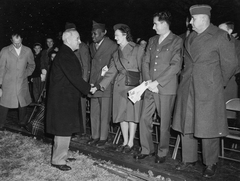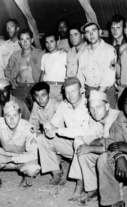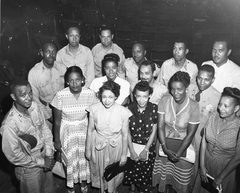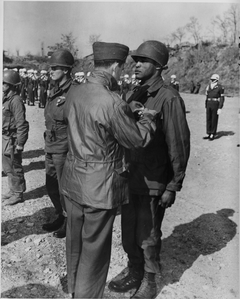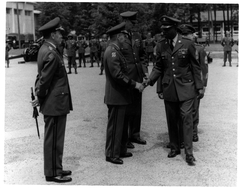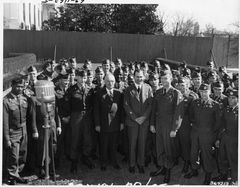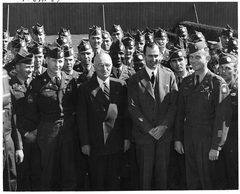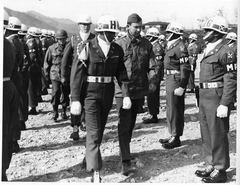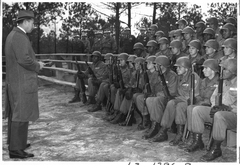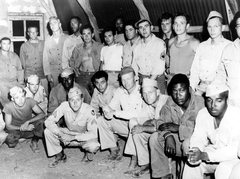This collection focuses on President Truman's decision to desegregate the U.S. Armed Forces. The collection includes documents covering the years 1938 through 1953. Supporting materials include photographs, oral history transcripts, a chronology, and the text of Freedom to Serve, the final report of the Fahy Committee.
Desegregation of the Armed Forces
Documents
1938
-
Letter from R. L. Vann to Dr. Ernest H. Wilkins, with Attachments, March 4, 1938 (NAID: 278078466)
Part of:
- recordGroup: Records of Temporary Committees, Commissions, and Boards, 1893 - 2008 (NAID: 547)
- Series: General Correspondence Files, 1948 - 1950 (NAID: 1701337)
- File Unit: V (NAID: 2789333)
1939
-
Letter from E. W. Kenworthy to Mr. Charles Fahy, March 4, 1939 (NAID: 257686784)
Part of:
- recordGroup: Records of Temporary Committees, Commissions, and Boards, 1893 - 2008 (NAID: 547)
- Series: Members and Staff Files, 1948 - 1950 (NAID: 1701333)
- File Unit: Fahy, Charles [Chairman]--March-December, 1949 (NAID: 2789220)
1940
-
Statement by President Franklin D. Roosevelt, October 1940 (NAID: 333234805)
Part of:
- Collection: David K. Niles Papers, 1909 - 1983 (NAID: 594711)
- Series: Civil Rights and Minorities Files, 1927 - 1952 (NAID: 1741412)
- File Unit: Civil Rights and Negro Affairs, 1936-1952: [1936] 1937-1944 (NAID: 3598726)
-
"The Negroes' Historical and Contemporary Role In National Defense", November 26, 1940 (NAID: 40019879)
Part of:
- recordGroup: Records of Temporary Committees, Commissions, and Boards, 1893 - 2008 (NAID: 547)
- Series: General Files, 1948 - 1950 (NAID: 1701345)
- File Unit: Colonel West A. Hamilton (Speech) (NAID: 2789430)
1941
-
Excerpts from Survey and Recommendations Concerning the Integration of the Negro Soldiers into the Army, Submitted to the Secretary of War by the Civilian Aide to the Secretary of War, September 22, 1941 (NAID: 278080997)
Part of:
- recordGroup: Records of Temporary Committees, Commissions, and Boards, 1893 - 2008 (NAID: 547)
- Series: Army Files, 1948 - 1950 (NAID: 1701340)
- File Unit: Utilization of Negroes (NAID: 2789387)
1942
-
Letter from Major General to Mr. John J. McCloy, August 27, 1942 (NAID: 245073449)
Part of:
- recordGroup: Records of Temporary Committees, Commissions, and Boards, 1893 - 2008 (NAID: 547)
- Series: Security Classified Records Files, 1948 - 1950 (NAID: 1701349)
- File Unit: McCloy Committee (NAID: 2789473)
1943
-
Memorandum from Colonel J. S. Leonard to the Assistant Secretary of War, May 25, 1943 (NAID: 245073461)
Part of:
- recordGroup: Records of Temporary Committees, Commissions, and Boards, 1893 - 2008 (NAID: 547)
- Series: Security Classified Records Files, 1948 - 1950 (NAID: 1701349)
- File Unit: McCloy Committee (NAID: 2789473)
-
Draft of Memorandum from I. H. E. for the Assistant Secretary of War, with Related Material, February 17, 1943 (NAID: 245073457)
Part of:
- recordGroup: Records of Temporary Committees, Commissions, and Boards, 1893 - 2008 (NAID: 547)
- Series: Security Classified Records Files, 1948 - 1950 (NAID: 1701349)
- File Unit: McCloy Committee (NAID: 2789473)
-
Draft of Memorandum from I. H. E. for the Chief of Staff, with Related Material, March 12, 1943 (NAID: 245073451)
Part of:
- recordGroup: Records of Temporary Committees, Commissions, and Boards, 1893 - 2008 (NAID: 547)
- Series: Security Classified Records Files, 1948 - 1950 (NAID: 1701349)
- File Unit: McCloy Committee (NAID: 2789473)
1944
-
Letter from Henry Stimson, Secretary of War, to Representative Hamilton Fish of New York, February 19, 1944 (NAID: 326803292)
Part of:
- Collection: Philleo Nash Papers, 1925 - 1998 (NAID: 623511)
- Series: White House Files, 1936 - 1953 (NAID: 1125612)
- File Unit: Minorities-Negro-General-Negro Combat Troops- Correspondence to Hamilton Fish and John J. McCloy, February 1944 (NAID: 1699005)
-
Letter from William Dawson to John McCloy, Assistant Secretary of War, February 28, 1944 (NAID: 326803289)
Part of:
- Collection: Philleo Nash Papers, 1925 - 1998 (NAID: 623511)
- Series: White House Files, 1936 - 1953 (NAID: 1125612)
- File Unit: Minorities-Negro-General-Negro Combat Troops- Correspondence to Hamilton Fish and John J. McCloy, February 1944 (NAID: 1699005)
-
Memorandum from Colonel J. S. Leonard for Members of the Advisory Committee on Negro Troop Policies, January 6, 1944 (NAID: 245073470)
Part of:
- recordGroup: Records of Temporary Committees, Commissions, and Boards, 1893 - 2008 (NAID: 547)
- Series: Security Classified Records Files, 1948 - 1950 (NAID: 1701349)
- File Unit: McCloy Committee (NAID: 2789473)
-
Memorandum from J. S. Leonard, Digest of War Department Policy Pertaining to Negro Military Personnel, January 1, 1944 (NAID: 245073464)
Part of:
- recordGroup: Records of Temporary Committees, Commissions, and Boards, 1893 - 2008 (NAID: 547)
- Series: Security Classified Records Files, 1948 - 1950 (NAID: 1701349)
- File Unit: McCloy Committee (NAID: 2789473)
-
Memorandum from Lieutenant General John C. H. Lee Regarding Volunteers for Training and Assignment as Reinforcements, December 26, 1944 (NAID: 40019889)
Part of:
- recordGroup: Records of Temporary Committees, Commissions, and Boards, 1893 - 2008 (NAID: 547)
- Series: Security Classified Records Files, 1948 - 1950 (NAID: 1701349)
- File Unit: General John C.H. Lee's Call for Volunteers (NAID: 2789471)
1945
-
Letter from John Sengstacke to Truman Gibson, Jr., with Attachment, February 7, 1945 (NAID: 326803310)
Part of:
- Collection: Philleo Nash Papers, 1925 - 1998 (NAID: 623511)
- Series: White House Files, 1936 - 1953 (NAID: 1125612)
- File Unit: Minorities-Negro-General-Negroes in the Armed Forces-News Clippings, Releases, Remarks of Howard C. Petersen, Assistant Secretary of War, at Luncheon for Negro Newspaper Publishers Association, March 1, 1946 (NAID: 1699013)
-
Report, Opinions about Negro Infantry Platoons in White Companies of 7 Divisions, July 3, 1945 (NAID: 278080420)
Part of:
- recordGroup: Records of Temporary Committees, Commissions, and Boards, 1893 - 2008 (NAID: 547)
- Series: Army Files, 1948 - 1950 (NAID: 1701340)
- File Unit: Negro Platoons in White Companies (NAID: 2789376)
-
Letter from General Joseph T. McNarney to Chief of Staff, War Department, August 13, 1945 (NAID: 245073866)
Part of:
- recordGroup: Records of Temporary Committees, Commissions, and Boards, 1893 - 2008 (NAID: 547)
- Series: Security Classified Records Files, 1948 - 1950 (NAID: 1701349)
- File Unit: Tompkins Report [memo on report, 1945] (NAID: 2789480)
-
Memorandum from Truman K. Gibson to John J. McCloy, August 8, 1945 (NAID: 245073475)
Part of:
- recordGroup: Records of Temporary Committees, Commissions, and Boards, 1893 - 2008 (NAID: 547)
- Series: Security Classified Records Files, 1948 - 1950 (NAID: 1701349)
- File Unit: McCloy Committee (NAID: 2789473)
-
Memorandum from Sommers to John J. McCloy, August 25, 1945 (NAID: 245073472)
Part of:
- recordGroup: Records of Temporary Committees, Commissions, and Boards, 1893 - 2008 (NAID: 547)
- Series: Security Classified Records Files, 1948 - 1950 (NAID: 1701349)
- File Unit: McCloy Committee (NAID: 2789473)
1946
-
Remarks of Howard C. Petersen, Assistant Secretary of War, March 1, 1946 (NAID: 326803308)
Part of:
- Collection: Philleo Nash Papers, 1925 - 1998 (NAID: 623511)
- Series: White House Files, 1936 - 1953 (NAID: 1125612)
- File Unit: Minorities-Negro-General-Negroes in the Armed Forces-News Clippings, Releases, Remarks of Howard C. Petersen, Assistant Secretary of War, at Luncheon for Negro Newspaper Publishers Association, March 1, 1946 (NAID: 1699013)
-
Memorandum from Philleo Nash to David Niles with Attachments, July 1946 (NAID: 301669628)
Part of:
- Collection: Philleo Nash White House Files (Truman Administration), 1945 - 1953 (NAID: 601103)
- Series: General Correspondence Files, 1939 - 1952 (NAID: 601107)
- File Unit: Army Segregation (NAID: 4757293)
-
Memorandum, Regular Army Negro Officer Personnel, June 1946 (NAID: 278080432)
Part of:
- recordGroup: Records of Temporary Committees, Commissions, and Boards, 1893 - 2008 (NAID: 547)
- Series: Army Files, 1948 - 1950 (NAID: 1701340)
- File Unit: Officer Personnel (NAID: 2789377)
-
War Department Circular Number 124, Utilization of Negro Manpower in the Postwar Army Policy, April 27, 1946 (NAID: 278080365)
Part of:
- recordGroup: Records of Temporary Committees, Commissions, and Boards, 1893 - 2008 (NAID: 547)
- Series: Army Files, 1948 - 1950 (NAID: 1701340)
- File Unit: Gillem Board Report (NAID: 2789373)
1947
-
Memorandum from Secretary of War Robert Patterson to the President's Committee on Civil Rights, May 15, 1947 (NAID: 333234692)
Part of:
- recordGroup: Records of Temporary Committees, Commissions, and Boards, 1893 - 2008 (NAID: 547)
- Series: General Correspondence with Government Departments and Agencies Files, 1946 - 1947 (NAID: 1701320)
- File Unit: War Department [1 of 3] (NAID: 2788054)
-
Memorandum from Robert K. Carr to Secretary of War Robert Patterson with Attachment, April 14, 1947 (NAID: 333234688)
Part of:
- recordGroup: Records of Temporary Committees, Commissions, and Boards, 1893 - 2008 (NAID: 547)
- Series: General Correspondence with Government Departments and Agencies Files, 1946 - 1947 (NAID: 1701320)
- File Unit: War Department [1 of 3] (NAID: 2788054)
-
Memorandum from Milton Stewart to Robert K. Carr, April 7, 1947 (NAID: 333234685)
Part of:
- recordGroup: Records of Temporary Committees, Commissions, and Boards, 1893 - 2008 (NAID: 547)
- Series: General Correspondence with Government Departments and Agencies Files, 1946 - 1947 (NAID: 1701320)
- File Unit: War Department [1 of 3] (NAID: 2788054)
-
Memorandum for the President's Committee on Civil Rights, April 21, 1947 (NAID: 333234674)
Part of:
- recordGroup: Records of Temporary Committees, Commissions, and Boards, 1893 - 2008 (NAID: 547)
- Series: General Correspondence with Government Departments and Agencies Files, 1946 - 1947 (NAID: 1701320)
- File Unit: Navy Department (NAID: 2788042)
-
Memorandum from R. W. Berry to Matthew Connelly, November 22, 1947 (NAID: 321497996)
Part of:
- Collection: President's Personal Files (Truman Administration), 1945 - 1953 (NAID: 583578)
- Series: President's Personal Files, 1945 - 1953 (NAID: 583579)
- File Unit: National Urban League, PPF 2685 (NAID: 829861)
-
Telegram from Bob McManus to William D. Hassett with Attached Newspaper Clipping, August 21, 1947 (NAID: 321496432)
Part of:
- Collection: Official Files (Truman Administration), 1945 - 1953 (NAID: 1202)
- Series: Official Files, 1945 - 1953 (NAID: 201124)
- File Unit: Segregation (Colored Question), 1945-June 1948, OF 93-B (NAID: 725632)
-
Letter from John M. Bailey to David Niles with Attachments, February 1947 (NAID: 301669645)
Part of:
- Collection: Philleo Nash White House Files (Truman Administration), 1945 - 1953 (NAID: 601103)
- Series: General Correspondence Files, 1939 - 1952 (NAID: 601107)
- File Unit: National Guard (Policy Regarding Race) (NAID: 4757411)
-
Memorandum from Robert K. Carr to Members of the President's Committee on Civil Rights, June 10, 1947 (NAID: 239791969)
Part of:
- recordGroup: Records of Temporary Committees, Commissions, and Boards, 1893 - 2008 (NAID: 547)
- Series: Staff Memoranda, Witnesses Statements to the Committee and Other Committee Documents Files, 1946 - 1947 (NAID: 1701326)
- File Unit: "Negroes in the Armed Forces"-Memo to the Pres. Comm. On Civil Rights-Prep. by Milton D. Stewart and Joseph Murtha (NAID: 2788365)
-
Correspondence Between Robert Carr and Edward H. Foley (NAID: 239790322)
Part of:
- recordGroup: Records of Temporary Committees, Commissions, and Boards, 1893 - 2008 (NAID: 547)
- Series: General Correspondence with Government Departments and Agencies Files, 1946 - 1947 (NAID: 1701320)
- File Unit: Coast Guard (NAID: 2788029)
-
Memorandum from Colonel L. B. Weeks, March 25, 1947 (NAID: 214916587)
Part of:
- Collection: Clark M. Clifford Papers, 1945 - 1980 (NAID: 1194)
- Series: Subject Files, 1946 - 1953 (NAID: 200613)
- File Unit: Segregation in Armed Forces, 1947-1949 (NAID: 1701243)
-
Letter from Secretary of War Robert Patterson to Senator Brien McMahon, March 7, 1947 (NAID: 214916584)
Part of:
- Collection: Clark M. Clifford Papers, 1945 - 1980 (NAID: 1194)
- Series: Subject Files, 1946 - 1953 (NAID: 200613)
- File Unit: Segregation in Armed Forces, 1947-1949 (NAID: 1701243)
-
Letter from Senator Brien McMahon to Secretary of War Robert Patterson, February 20, 1947 (NAID: 214916582)
Part of:
- Collection: Clark M. Clifford Papers, 1945 - 1980 (NAID: 1194)
- Series: Subject Files, 1946 - 1953 (NAID: 200613)
- File Unit: Segregation in Armed Forces, 1947-1949 (NAID: 1701243)
1948
-
Memorandum from Donald Dawson to President Harry S. Truman, September 9, 1948 (NAID: 333234903)
Part of:
- Collection: Philleo Nash White House Files (Truman Administration), 1945 - 1953 (NAID: 601103)
- Series: General Correspondence Files, 1939 - 1952 (NAID: 601107)
- File Unit: Armed Forces [1 of 2] (NAID: 4757291)
-
Memorandum from President Harry S. Truman to David Niles with Attachment, March 22, 1948 (NAID: 333234867)
Part of:
- Collection: David K. Niles Papers, 1909 - 1983 (NAID: 594711)
- Series: Civil Rights and Minorities Files, 1927 - 1952 (NAID: 1741412)
- File Unit: Civil Rights and Negro Affairs, 1936-1952: [1948] 1949-1952 (NAID: 3598731)
-
Memoranda from Donald Dawson to President Harry S. Truman, September 9, 1948 (NAID: 321496739)
Part of:
- Collection: Official Files (Truman Administration), 1945 - 1953 (NAID: 1202)
- Series: Official Files, 1945 - 1953 (NAID: 201124)
- File Unit: President's Committee on Equality of Treatment and Opportunity in the Armed Forces (Department of Defense), 1948-April 1950, OF 1285-O (NAID: 728313)
-
Telegram from Ralph McGill to Donald Dawson with Unsent Reply and Related Material (NAID: 321496733)
Part of:
- Collection: Official Files (Truman Administration), 1945 - 1953 (NAID: 1202)
- Series: Official Files, 1945 - 1953 (NAID: 201124)
- File Unit: President's Committee on Equality of Treatment and Opportunity in the Armed Forces (Department of Defense), 1948-April 1950, OF 1285-O (NAID: 728313)
-
Memorandum from Secretary of Defense James Forrestal to President Harry S. Truman with Notes and Related Material, August 1948 (NAID: 321496686)
Part of:
- Collection: Official Files (Truman Administration), 1945 - 1953 (NAID: 1202)
- Series: Official Files, 1945 - 1953 (NAID: 201124)
- File Unit: President's Committee on Equality of Treatment and Opportunity in the Armed Forces (Department of Defense), 1948-April 1950, OF 1285-O (NAID: 728313)
-
Letter from Grant Reynolds and A. Philip Randolph to President Harry S. Truman with Internal White House Memoranda (NAID: 321496470)
Part of:
- Collection: Official Files (Truman Administration), 1945 - 1953 (NAID: 1202)
- Series: Official Files, 1945 - 1953 (NAID: 201124)
- File Unit: Segregation (Colored Question), 1945-June 1948, OF 93-B (NAID: 725632)
-
Letter from A. Philip Randolph to President Harry S. Truman with a Memorandum from President Harry S. Truman to David Niles (NAID: 321496467)
Part of:
- Collection: Official Files (Truman Administration), 1945 - 1953 (NAID: 1202)
- Series: Official Files, 1945 - 1953 (NAID: 201124)
- File Unit: Segregation (Colored Question), 1945-June 1948, OF 93-B (NAID: 725632)
-
Letter from A. Philip Randolph to President Harry S. Truman with a Reply from Matthew Connelly with Related Material (NAID: 321496447)
Part of:
- Collection: Official Files (Truman Administration), 1945 - 1953 (NAID: 1202)
- Series: Official Files, 1945 - 1953 (NAID: 201124)
- File Unit: Segregation (Colored Question), 1945-June 1948, OF 93-B (NAID: 725632)
-
Letter from Dr. Howard Davis to President Harry S. Truman with a Reply from David Niles, with Related Material, May 1948 (NAID: 321496441)
Part of:
- Collection: Official Files (Truman Administration), 1945 - 1953 (NAID: 1202)
- Series: Official Files, 1945 - 1953 (NAID: 201124)
- File Unit: Segregation (Colored Question), 1945-June 1948, OF 93-B (NAID: 725632)
-
Letter from Hubert Humphrey to Secretary of Defense James Forrestal, April 26, 1948 (NAID: 321496428)
Part of:
- Collection: Official Files (Truman Administration), 1945 - 1953 (NAID: 1202)
- Series: Official Files, 1945 - 1953 (NAID: 201124)
- File Unit: Segregation (Colored Question), 1945-June 1948, OF 93-B (NAID: 725632)
-
Letters from Grant Reynolds and A. Philip Randolph to President Harry S. Truman with Attachments and Related Materials (NAID: 321495826)
Part of:
- Collection: Official Files (Truman Administration), 1945 - 1953 (NAID: 1202)
- Series: Official Files, 1945 - 1953 (NAID: 201124)
- File Unit: Segregation (Colored Question), July 1948-June 1949, OF 93-B (NAID: 313173027)
-
Correspondence Between John R. Steelman and Richard Givens, July 1948 (NAID: 321495823)
Part of:
- Collection: Official Files (Truman Administration), 1945 - 1953 (NAID: 1202)
- Series: Official Files, 1945 - 1953 (NAID: 201124)
- File Unit: Segregation (Colored Question), July 1948-June 1949, OF 93-B (NAID: 313173027)
-
Telegram from Alvin Jones to President Harry S. Truman, July 31, 1948 (NAID: 321495819)
Part of:
- Collection: Official Files (Truman Administration), 1945 - 1953 (NAID: 1202)
- Series: Official Files, 1945 - 1953 (NAID: 201124)
- File Unit: Segregation (Colored Question), July 1948-June 1949, OF 93-B (NAID: 313173027)
-
Letter from Adolf Berle, Jr. to President Harry S. Truman with a Reply from Clark Clifford, August 1948 (NAID: 321495815)
Part of:
- Collection: Official Files (Truman Administration), 1945 - 1953 (NAID: 1202)
- Series: Official Files, 1945 - 1953 (NAID: 201124)
- File Unit: Segregation (Colored Question), July 1948-June 1949, OF 93-B (NAID: 313173027)
-
Letter from Mr. and Mrs. H. Leon Bradlow to President Harry S. Truman with a Reply from William D. Hassett, November 1948 (NAID: 321495723)
Part of:
- Collection: Official Files (Truman Administration), 1945 - 1953 (NAID: 1202)
- Series: Official Files, 1945 - 1953 (NAID: 201124)
- File Unit: President's Committee on Equality of Treatment and Opportunity in the Armed Forces (Department of Defense) - Miscellaneous, OF 1285-O (NAID: 312415503)
-
Letter from Leo Higgs to President Harry S. Truman with a Reply from Matthew Connelly (NAID: 321495717)
Part of:
- Collection: Official Files (Truman Administration), 1945 - 1953 (NAID: 1202)
- Series: Official Files, 1945 - 1953 (NAID: 201124)
- File Unit: President's Committee on Equality of Treatment and Opportunity in the Armed Forces (Department of Defense) - Miscellaneous, OF 1285-O (NAID: 312415503)
-
Correspondence Between Donald Dawson and Ralph McGill (NAID: 301669775)
Part of:
- Collection: Philleo Nash White House Files (Truman Administration), 1945 - 1953 (NAID: 601103)
- Series: President's Committee on Equality of Treatment and Opportunity in the Armed Services Files, 1948 - 1952 (NAID: 601113)
- File Unit: President's Committee on Equality of Treatment and Opportunity in the Armed Services (NAID: 4757624)
-
Note from J. S. to Mr. D., September 8, 1948 (NAID: 301669773)
Part of:
- Collection: Philleo Nash White House Files (Truman Administration), 1945 - 1953 (NAID: 601103)
- Series: President's Committee on Equality of Treatment and Opportunity in the Armed Services Files, 1948 - 1952 (NAID: 601113)
- File Unit: President's Committee on Equality of Treatment and Opportunity in the Armed Services (NAID: 4757624)
-
Letter from P. Clifton Reynolds to President Harry S. Truman with a Reply from David Niles (NAID: 301669770)
Part of:
- Collection: Philleo Nash White House Files (Truman Administration), 1945 - 1953 (NAID: 601103)
- Series: President's Committee on Equality of Treatment and Opportunity in the Armed Services Files, 1948 - 1952 (NAID: 601113)
- File Unit: President's Committee on Equality of Treatment and Opportunity in the Armed Services (NAID: 4757624)
-
Draft Memorandum from President Harry S. Truman to Secretary of Defense James Forrestal, April 9, 1948 (NAID: 301669663)
Part of:
- Collection: Philleo Nash White House Files (Truman Administration), 1945 - 1953 (NAID: 601103)
- Series: General Correspondence Files, 1939 - 1952 (NAID: 601107)
- File Unit: National Guard (Policy Regarding Race) (NAID: 4757411)
-
Memorandum from Philleo Nash to Clark Clifford with Attachments, April 9, 1948 (NAID: 301669658)
Part of:
- Collection: Philleo Nash White House Files (Truman Administration), 1945 - 1953 (NAID: 601103)
- Series: General Correspondence Files, 1939 - 1952 (NAID: 601107)
- File Unit: National Guard (Policy Regarding Race) (NAID: 4757411)
-
Department of the Army Press Release [Misdated 1947], February 7, 1948 (NAID: 301669641)
Part of:
- Collection: Philleo Nash White House Files (Truman Administration), 1945 - 1953 (NAID: 601103)
- Series: General Correspondence Files, 1939 - 1952 (NAID: 601107)
- File Unit: National Guard (Policy Regarding Race) (NAID: 4757411)
-
Memorandum from David Niles to Clark Clifford with Attachment, May 1948 (NAID: 301669637)
Part of:
- Collection: Philleo Nash White House Files (Truman Administration), 1945 - 1953 (NAID: 601103)
- Series: General Correspondence Files, 1939 - 1952 (NAID: 601107)
- File Unit: Army Segregation (NAID: 4757293)
-
Memorandum from George Elsey to Philleo Nash with Attachment and Notes, April 1948 (NAID: 301668162)
Part of:
- Collection: George M. Elsey Papers, 1916 - 1995 (NAID: 600073)
- Series: Speech Files, 1946 - 1953 (NAID: 167966991)
- File Unit: 1948, February 2: Civil Rights Message - Press Releases (NAID: 169629697)
-
Memorandum from Marx Leva to George Elsey with Attachment, April 1948 (NAID: 301668158)
Part of:
- Collection: George M. Elsey Papers, 1916 - 1995 (NAID: 600073)
- Series: Speech Files, 1946 - 1953 (NAID: 167966991)
- File Unit: 1948, February 2: Civil Rights Message - Press Releases (NAID: 169629697)
-
Correspondence Between George Elsey and Philleo Nash, September 1948 (NAID: 301668153)
Part of:
- Collection: George M. Elsey Papers, 1916 - 1995 (NAID: 600073)
- Series: Speech Files, 1946 - 1953 (NAID: 167966991)
- File Unit: 1948, February 2: Civil Rights Message - Committee on Equality of Opportunity in the Armed Forces (NAID: 169629692)
-
Memorandum from George Elsey to Clark Clifford, April 19, 1948 (NAID: 301668151)
Part of:
- Collection: George M. Elsey Papers, 1916 - 1995 (NAID: 600073)
- Series: Speech Files, 1946 - 1953 (NAID: 167966991)
- File Unit: 1948, February 2: Civil Rights Message - Committee on Equality of Opportunity in the Armed Forces (NAID: 169629692)
-
Memorandum from Clark Clifford to President Harry S. Truman with Attachment and Related Material, April 1948 (NAID: 301668141)
Part of:
- Collection: George M. Elsey Papers, 1916 - 1995 (NAID: 600073)
- Series: Speech Files, 1946 - 1953 (NAID: 167966991)
- File Unit: 1948, February 2: Civil Rights Message - Committee on Equality of Opportunity in the Armed Forces (NAID: 169629692)
-
Memorandum from Secretary of the Army Kenneth Royall to Clark Clifford with Attachments, March 22, 1948 (NAID: 301668134)
Part of:
- Collection: George M. Elsey Papers, 1916 - 1995 (NAID: 600073)
- Series: Speech Files, 1946 - 1953 (NAID: 167966991)
- File Unit: 1948, February 2: Civil Rights Message - Committee on Equality of Opportunity in the Armed Forces (NAID: 169629692)
-
Note from Mary Weiler, January 29, 1948 (NAID: 301668119)
Part of:
- Collection: George M. Elsey Papers, 1916 - 1995 (NAID: 600073)
- Series: Speech Files, 1946 - 1953 (NAID: 167966991)
- File Unit: 1948, February 2: Civil Rights Message (NAID: 169629690)
-
Memorandum from Secretary of the Army Kenneth C. Royall to the Secretary of Defense Louis Johnson, December 2, 1948 (NAID: 278079392)
Part of:
- recordGroup: Records of Temporary Committees, Commissions, and Boards, 1893 - 2008 (NAID: 547)
- Series: Army Files, 1948 - 1950 (NAID: 1701340)
- File Unit: Experimental Units--Royall Plan (NAID: 2789360)
-
Memorandum, A Proposed Experimental Plan for Integration (NAID: 278079389)
Part of:
- recordGroup: Records of Temporary Committees, Commissions, and Boards, 1893 - 2008 (NAID: 547)
- Series: Army Files, 1948 - 1950 (NAID: 1701340)
- File Unit: Experimental Units--Royall Plan (NAID: 2789360)
-
Memorandum from Secretary of Defense James Forrestal to the Secretaries of the Army, the Navy, and the Air Force, October 21, 1948 (NAID: 257688212)
Part of:
- recordGroup: Records of Temporary Committees, Commissions, and Boards, 1893 - 2008 (NAID: 547)
- Series: Meetings Files, 1948 - 1950 (NAID: 1701334)
- File Unit: January 12, 1949--Meeting with President (NAID: 2789229)
-
Memorandum from Secretary of Defense James Forrestal, with Attachment, December 30, 1948 (NAID: 257688198)
Part of:
- recordGroup: Records of Temporary Committees, Commissions, and Boards, 1893 - 2008 (NAID: 547)
- Series: Members and Staff Files, 1948 - 1950 (NAID: 1701333)
- File Unit: Military Liaison with Committee (NAID: 2789228)
-
Memorandum from Acting Secretary of the Navy John Nicholas Brown to Secretary of Defense James V. Forrestal, Secretary of the Air Force Stuart Symington, and Secretary of the Army Kenneth Royall, December 28, 1948 (NAID: 245073423)
Part of:
- recordGroup: Records of Temporary Committees, Commissions, and Boards, 1893 - 2008 (NAID: 547)
- Series: Security Classified Records Files, 1948 - 1950 (NAID: 1701349)
- File Unit: Armed Services--Experimental Units (NAID: 2789469)
-
Memorandum from Secretary of the Air Force W. Stuart Symington to Secretary of Defense James V. Forrestal with Attachment, December 22, 1948 (NAID: 245073418)
Part of:
- recordGroup: Records of Temporary Committees, Commissions, and Boards, 1893 - 2008 (NAID: 547)
- Series: Security Classified Records Files, 1948 - 1950 (NAID: 1701349)
- File Unit: Armed Services--Experimental Units (NAID: 2789469)
-
Memorandum from Clark Clifford to Secretary of the Army Kenneth Royall, with Attachment, September 2, 1948 (NAID: 214916772)
Part of:
- Collection: Clark M. Clifford Papers, 1945 - 1980 (NAID: 1194)
- Series: Subject Files, 1946 - 1953 (NAID: 200613)
- File Unit: Segregation in Armed Forces, 1947-1949 (NAID: 1701243)
-
Memorandum from Philleo Nash to Clark Clifford, September 2, 1948 (NAID: 214916769)
Part of:
- Collection: Clark M. Clifford Papers, 1945 - 1980 (NAID: 1194)
- Series: Subject Files, 1946 - 1953 (NAID: 200613)
- File Unit: Segregation in Armed Forces, 1947-1949 (NAID: 1701243)
-
Memorandum from Clark Clifford to Secretary of the Army Kenneth Royall, September 2, 1948 (NAID: 214916767)
Part of:
- Collection: Clark M. Clifford Papers, 1945 - 1980 (NAID: 1194)
- Series: Subject Files, 1946 - 1953 (NAID: 200613)
- File Unit: Segregation in Armed Forces, 1947-1949 (NAID: 1701243)
-
Letter from Clark Clifford to Secretary of the Army Kenneth Royall, August 10, 1948 (NAID: 214916722)
Part of:
- Collection: Clark M. Clifford Papers, 1945 - 1980 (NAID: 1194)
- Series: Subject Files, 1946 - 1953 (NAID: 200613)
- File Unit: Segregation in Armed Forces, 1947-1949 (NAID: 1701243)
-
Memorandum from Secretary of the Army Kenneth Royall to Clark Clifford, with Attachments, July 23, 1948 (NAID: 214916698)
Part of:
- Collection: Clark M. Clifford Papers, 1945 - 1980 (NAID: 1194)
- Series: Subject Files, 1946 - 1953 (NAID: 200613)
- File Unit: Segregation in Armed Forces, 1947-1949 (NAID: 1701243)
-
Correspondence Between Clark Clifford and Secretary of the Army Kenneth Royall, with Attachment, July 19, 1948 (NAID: 214916692)
Part of:
- Collection: Clark M. Clifford Papers, 1945 - 1980 (NAID: 1194)
- Series: Subject Files, 1946 - 1953 (NAID: 200613)
- File Unit: Segregation in Armed Forces, 1947-1949 (NAID: 1701243)
-
Memorandum from George Elsey to David Niles, with Attachment, July 13, 1948 (NAID: 214916687)
Part of:
- Collection: Clark M. Clifford Papers, 1945 - 1980 (NAID: 1194)
- Series: Subject Files, 1946 - 1953 (NAID: 200613)
- File Unit: Segregation in Armed Forces, 1947-1949 (NAID: 1701243)
-
Memorandum from David Niles to Clark Clifford, June 30, 1948 (NAID: 214916685)
Part of:
- Collection: Clark M. Clifford Papers, 1945 - 1980 (NAID: 1194)
- Series: Subject Files, 1946 - 1953 (NAID: 200613)
- File Unit: Segregation in Armed Forces, 1947-1949 (NAID: 1701243)
-
Memorandum from Secretary of the Army Kenneth Royall to Clark Clifford, with Attachments, August 6, 1948 (NAID: 214916657)
Part of:
- Collection: Clark M. Clifford Papers, 1945 - 1980 (NAID: 1194)
- Series: Subject Files, 1946 - 1953 (NAID: 200613)
- File Unit: Segregation in Armed Forces, 1947-1949 (NAID: 1701243)
-
Memorandum from Secretary of the Army Kenneth Royall to Secretary of Defense James Forrestal, with Attachments, May 4, 1948 (NAID: 214916645)
Part of:
- Collection: Clark M. Clifford Papers, 1945 - 1980 (NAID: 1194)
- Series: Subject Files, 1946 - 1953 (NAID: 200613)
- File Unit: Segregation in Armed Forces, 1947-1949 (NAID: 1701243)
-
Memorandum from Philleo Nash to Clark Clifford, with Attachments and Related Material, April 9, 1948 (NAID: 214916637)
Part of:
- Collection: Clark M. Clifford Papers, 1945 - 1980 (NAID: 1194)
- Series: Subject Files, 1946 - 1953 (NAID: 200613)
- File Unit: Segregation in Armed Forces, 1947-1949 (NAID: 1701243)
-
Memorandum from Secretary of the Army Kenneth Royall to Clark Clifford, with Attachments, March 1948 (NAID: 214916632)
Part of:
- Collection: Clark M. Clifford Papers, 1945 - 1980 (NAID: 1194)
- Series: Subject Files, 1946 - 1953 (NAID: 200613)
- File Unit: Segregation in Armed Forces, 1947-1949 (NAID: 1701243)
-
Letter from Secretary of the Army Kenneth Royall to President Harry S. Truman, September 17, 1948 (NAID: 183567844)
Part of:
- Collection: President's Secretary's Files (Truman Administration), 1945 - 1960 (NAID: 1205)
- Series: Subject Files, 1945 - 1953 (NAID: 602191)
- File Unit: Agencies File, 1945-1953: Military: Committee on Equality of Treatment and Opportunity in the Armed Services (Fahy Committee) (NAID: 749910)
-
Letter from Leon Henderson to President Harry S. Truman, July 22, 1948 (NAID: 40020016)
Part of:
- Collection: Official Files (Truman Administration), 1945 - 1953 (NAID: 1202)
- Series: Official Files, 1945 - 1953 (NAID: 201124)
- File Unit: Segregation (Colored Question), July 1948-June 1949, OF 93-B (NAID: 313173027)
-
Letter from Mr. and Mrs. Irvin Dagen to President Harry S. Truman, June 15, 1948 (NAID: 40020013)
Part of:
- Collection: Official Files (Truman Administration), 1945 - 1953 (NAID: 1202)
- Series: Official Files, 1945 - 1953 (NAID: 201124)
- File Unit: Segregation (Colored Question), July 1948-June 1949, OF 93-B (NAID: 313173027)
-
Memorandum Regarding the President's Civil Rights Message on the Armed Forces, May 11, 1948 (NAID: 40019946)
Part of:
- Collection: Clark M. Clifford Papers, 1945 - 1980 (NAID: 1194)
- Series: Subject Files, 1946 - 1953 (NAID: 200613)
- File Unit: Segregation in Armed Forces, 1947-1949 (NAID: 1701243)
-
Executive Order 9981 dated July 26, 1948, Establishing the President's Committee on Equality of Treatment and Opportunity in the Armed Services, July 26, 1948 (NAID: 300009)
Part of:
- recordGroup: General Records of the United States Government, 1778 - 2006 (NAID: 340)
- Series: Executive Orders, 1862 - 2020 (NAID: 299999)
1949
-
Memorandum from David Niles to President Harry S. Truman, October 5, 1949 (NAID: 333234875)
Part of:
- Collection: David K. Niles Papers, 1909 - 1983 (NAID: 594711)
- Series: Civil Rights and Minorities Files, 1927 - 1952 (NAID: 1741412)
- File Unit: Civil Rights and Negro Affairs, 1936-1952: [1948] 1949-1952 (NAID: 3598731)
-
Correspondence Between David Niles and Chester Bowles, November 1949 (NAID: 333234871)
Part of:
- Collection: David K. Niles Papers, 1909 - 1983 (NAID: 594711)
- Series: Civil Rights and Minorities Files, 1927 - 1952 (NAID: 1741412)
- File Unit: Civil Rights and Negro Affairs, 1936-1952: [1948] 1949-1952 (NAID: 3598731)
-
Letter from Charles Fahy to President Harry S. Truman with Attachments and Notes, July 1949 (NAID: 321496776)
Part of:
- Collection: Official Files (Truman Administration), 1945 - 1953 (NAID: 1202)
- Series: Official Files, 1945 - 1953 (NAID: 201124)
- File Unit: President's Committee on Equality of Treatment and Opportunity in the Armed Forces (Department of Defense), 1948-April 1950, OF 1285-O (NAID: 728313)
-
Correspondence Between Donald Dawson and David Niles, June 1949 (NAID: 321496772)
Part of:
- Collection: Official Files (Truman Administration), 1945 - 1953 (NAID: 1202)
- Series: Official Files, 1945 - 1953 (NAID: 201124)
- File Unit: President's Committee on Equality of Treatment and Opportunity in the Armed Forces (Department of Defense), 1948-April 1950, OF 1285-O (NAID: 728313)
-
Letters from Charles Fahy to David Niles (NAID: 321496769)
Part of:
- Collection: Official Files (Truman Administration), 1945 - 1953 (NAID: 1202)
- Series: Official Files, 1945 - 1953 (NAID: 201124)
- File Unit: President's Committee on Equality of Treatment and Opportunity in the Armed Forces (Department of Defense), 1948-April 1950, OF 1285-O (NAID: 728313)
-
Correspondence Between Donald Dawson and Senator Brien McMahon with Attachment and Related Material (NAID: 321496760)
Part of:
- Collection: Official Files (Truman Administration), 1945 - 1953 (NAID: 1202)
- Series: Official Files, 1945 - 1953 (NAID: 201124)
- File Unit: President's Committee on Equality of Treatment and Opportunity in the Armed Forces (Department of Defense), 1948-April 1950, OF 1285-O (NAID: 728313)
-
Memorandum from Charles Ross to Donald Dawson with Attachment and Related Material, January 1949 (NAID: 321496744)
Part of:
- Collection: Official Files (Truman Administration), 1945 - 1953 (NAID: 1202)
- Series: Official Files, 1945 - 1953 (NAID: 201124)
- File Unit: President's Committee on Equality of Treatment and Opportunity in the Armed Forces (Department of Defense), 1948-April 1950, OF 1285-O (NAID: 728313)
-
Memorandum, List of Persons Who Will be Present at the President's Meeting with the Committee on Equality of Treatment and Opportunity in the Armed Services, January 1949 (NAID: 321496742)
Part of:
- Collection: Official Files (Truman Administration), 1945 - 1953 (NAID: 1202)
- Series: Official Files, 1945 - 1953 (NAID: 201124)
- File Unit: President's Committee on Equality of Treatment and Opportunity in the Armed Forces (Department of Defense), 1948-April 1950, OF 1285-O (NAID: 728313)
-
Correspondence Between Senator Ralph Flanders and President Harry S. Truman, December 1949 (NAID: 321495886)
Part of:
- Collection: Official Files (Truman Administration), 1945 - 1953 (NAID: 1202)
- Series: Official Files, 1945 - 1953 (NAID: 201124)
- File Unit: Segregation (Colored Question), July-December 1949, OF 93-B (NAID: 313173028)
-
Correspondence Between Seantor Paul Douglas and President Harry S. Truman, December 1949 (NAID: 321495883)
Part of:
- Collection: Official Files (Truman Administration), 1945 - 1953 (NAID: 1202)
- Series: Official Files, 1945 - 1953 (NAID: 201124)
- File Unit: Segregation (Colored Question), July-December 1949, OF 93-B (NAID: 313173028)
-
Correspondence Between Senator Irving Ives and President Harry S. Truman, December 1949 (NAID: 321495880)
Part of:
- Collection: Official Files (Truman Administration), 1945 - 1953 (NAID: 1202)
- Series: Official Files, 1945 - 1953 (NAID: 201124)
- File Unit: Segregation (Colored Question), July-December 1949, OF 93-B (NAID: 313173028)
-
Letter from Joseph Beauharnais to President Harry S. Truman with Attachment, June 24, 1949 (NAID: 321495852)
Part of:
- Collection: Official Files (Truman Administration), 1945 - 1953 (NAID: 1202)
- Series: Official Files, 1945 - 1953 (NAID: 201124)
- File Unit: Segregation (Colored Question), July 1948-June 1949, OF 93-B (NAID: 313173027)
-
Letter from Sherman Hibbitt to Matthew Connelly with Related Materials (NAID: 321495726)
Part of:
- Collection: Official Files (Truman Administration), 1945 - 1953 (NAID: 1202)
- Series: Official Files, 1945 - 1953 (NAID: 201124)
- File Unit: President's Committee on Equality of Treatment and Opportunity in the Armed Forces (Department of Defense) - Miscellaneous, OF 1285-O (NAID: 312415503)
-
Press Releases from the Department of Defense and Americans for Democratic Action (NAID: 301669811)
Part of:
- Collection: Philleo Nash White House Files (Truman Administration), 1945 - 1953 (NAID: 601103)
- Series: President's Committee on Equality of Treatment and Opportunity in the Armed Services Files, 1948 - 1952 (NAID: 601113)
- File Unit: Press Releases and Newspaper Clippings (NAID: 4757625)
-
Note on Telephone Call from Charles Fahy, October 3, 1949 (NAID: 301669768)
Part of:
- Collection: Philleo Nash White House Files (Truman Administration), 1945 - 1953 (NAID: 601103)
- Series: President's Committee on Equality of Treatment and Opportunity in the Armed Services Files, 1948 - 1952 (NAID: 601113)
- File Unit: Correspondence (NAID: 4757617)
-
Memorandum from David Niles to President Harry S. Truman, October 4, 1949 (NAID: 301669765)
Part of:
- Collection: Philleo Nash White House Files (Truman Administration), 1945 - 1953 (NAID: 601103)
- Series: President's Committee on Equality of Treatment and Opportunity in the Armed Services Files, 1948 - 1952 (NAID: 601113)
- File Unit: Correspondence (NAID: 4757617)
-
Memoranda from Stephen Spingarn to Philleo Nash with Attachments (NAID: 301669592)
Part of:
- Collection: Philleo Nash White House Files (Truman Administration), 1945 - 1953 (NAID: 601103)
- Series: General Correspondence Files, 1939 - 1952 (NAID: 601107)
- File Unit: Armed Forces [1 of 2] (NAID: 4757291)
-
Memorandum for Charles Fahy, June 14, 1949 (NAID: 284923114)
Part of:
- recordGroup: Records of Temporary Committees, Commissions, and Boards, 1893 - 2008 (NAID: 547)
- Series: General Files, 1948 - 1950 (NAID: 1701345)
- File Unit: Noble Report--1948 (NAID: 2789438)
-
Memorandum, Utilization of Negro Manpower in the Army, November 16, 1949 (NAID: 284918885)
Part of:
- recordGroup: Records of Temporary Committees, Commissions, and Boards, 1893 - 2008 (NAID: 547)
- Series: Army Policy Files, 1948 - 1950 (NAID: 1701341)
- File Unit: Revised 124 (Correspondence) (NAID: 2789403)
-
Memorandum from E. W. Kenworthy to the President's Committee on Equality of Treatment and Opportunity in the Armed Services, November 18, 1949 (NAID: 284918882)
Part of:
- recordGroup: Records of Temporary Committees, Commissions, and Boards, 1893 - 2008 (NAID: 547)
- Series: Army Policy Files, 1948 - 1950 (NAID: 1701341)
- File Unit: Revised 124 (Correspondence) (NAID: 2789403)
-
Memorandum from Charles Fahy to the Secretary of the Army, July 25, 1949 (NAID: 284918552)
Part of:
- recordGroup: Records of Temporary Committees, Commissions, and Boards, 1893 - 2008 (NAID: 547)
- Series: Army Policy Files, 1948 - 1950 (NAID: 1701341)
- File Unit: Third Reply to Johnson--Outline Plan--Committee Evaluation of (Drafts) (NAID: 2789392)
-
Letter from John H. Sengstacke to Charles Fahy, with Enclosure, July 14, 1949 (NAID: 284918541)
Part of:
- recordGroup: Records of Temporary Committees, Commissions, and Boards, 1893 - 2008 (NAID: 547)
- Series: Army Policy Files, 1948 - 1950 (NAID: 1701341)
- File Unit: Third Reply to Johnson--Outline Plan--Committee Evaluation of (Drafts) (NAID: 2789392)
-
Memorandum from E. W. Kenworthy to the Fahy Committee, July 6, 1949 (NAID: 284918488)
Part of:
- recordGroup: Records of Temporary Committees, Commissions, and Boards, 1893 - 2008 (NAID: 547)
- Series: Army Policy Files, 1948 - 1950 (NAID: 1701341)
- File Unit: Third Reply to Johnson--Outline Plan--Committee Evaluation of (Drafts) (NAID: 2789392)
-
Proposed Draft of Special Regulation Replacing WD CIR 124, Utilization of Negro Manpower in the Army, November 16, 1949 (NAID: 278081011)
Part of:
- recordGroup: Records of Temporary Committees, Commissions, and Boards, 1893 - 2008 (NAID: 547)
- Series: Army Files, 1948 - 1950 (NAID: 1701340)
- File Unit: Utilization of Negroes (NAID: 2789387)
-
Department of Defense Press Release, September 30, 1949 (NAID: 278080486)
Part of:
- recordGroup: Records of Temporary Committees, Commissions, and Boards, 1893 - 2008 (NAID: 547)
- Series: Army Files, 1948 - 1950 (NAID: 1701340)
- File Unit: Press Releases--New Policy (NAID: 2789379)
-
Letter from E. W. Kenworthy to the Secretary of the Army Kenneth Royall, March 22, 1949 (NAID: 278080395)
Part of:
- recordGroup: Records of Temporary Committees, Commissions, and Boards, 1893 - 2008 (NAID: 547)
- Series: Army Files, 1948 - 1950 (NAID: 1701340)
- File Unit: Gillem Board Report (NAID: 2789373)
-
Memorandum from E. W. Kenworthy to Charles Fahy, with Enclosures, September 28, 1949 (NAID: 278080356)
Part of:
- recordGroup: Records of Temporary Committees, Commissions, and Boards, 1893 - 2008 (NAID: 547)
- Series: Army Files, 1948 - 1950 (NAID: 1701340)
- File Unit: Gillem Board Hearings (NAID: 2789372)
-
Memorandum from Joseph H. B. Evans for the Fahy Committee, August 12, 1949 (NAID: 278080349)
Part of:
- recordGroup: Records of Temporary Committees, Commissions, and Boards, 1893 - 2008 (NAID: 547)
- Series: Army Files, 1948 - 1950 (NAID: 1701340)
- File Unit: Gillem Board Hearings (NAID: 2789372)
-
Department of Defense Press Release, "The Negro in the Army: A Special Report Prepared by the Office of the Civilian Aide to the Secretary of the Army", April 28, 1949 (NAID: 278080170)
Part of:
- recordGroup: Records of Temporary Committees, Commissions, and Boards, 1893 - 2008 (NAID: 547)
- Series: Army Files, 1948 - 1950 (NAID: 1701340)
- File Unit: General Printed Material (NAID: 2789370)
-
Statement by General Omar Bradley, Chief of Staff Before the President's Committee on Equality of Treatment and Opportunity in the Armed Forces, March 28, 1949 (NAID: 278079382)
Part of:
- recordGroup: Records of Temporary Committees, Commissions, and Boards, 1893 - 2008 (NAID: 547)
- Series: Army Files, 1948 - 1950 (NAID: 1701340)
- File Unit: Experimental Units--Royall Plan (NAID: 2789360)
-
Memorandum from E. W. Kenworthy to Charles Fahy, Final Copy, May 30, 1949 (NAID: 278079174)
Part of:
- recordGroup: Records of Temporary Committees, Commissions, and Boards, 1893 - 2008 (NAID: 547)
- Series: Armed Services Files, 1948 - 1950 (NAID: 1701339)
- File Unit: 2nd Reply to Johnson-Committee Analysis (Drafts) (NAID: 2789353)
-
Memorandum from Acting Secretary of the Navy Dan A. Kimball to Secretary of Defense Louis Johnson, May 23, 1949 (NAID: 278079156)
Part of:
- recordGroup: Records of Temporary Committees, Commissions, and Boards, 1893 - 2008 (NAID: 547)
- Series: Armed Services Files, 1948 - 1950 (NAID: 1701339)
- File Unit: 2nd Replies of Army and Navy--FC IX (NAID: 2789352)
-
Memorandum from Acting Secretary of the Army Gordon Gray to Secretary of Defense Louis Johnson, May 26, 1949 (NAID: 278079147)
Part of:
- recordGroup: Records of Temporary Committees, Commissions, and Boards, 1893 - 2008 (NAID: 547)
- Series: Armed Services Files, 1948 - 1950 (NAID: 1701339)
- File Unit: 2nd Replies of Army and Navy--FC IX (NAID: 2789352)
-
Department of Defense Press Release, May 11, 1949 (NAID: 278079144)
Part of:
- recordGroup: Records of Temporary Committees, Commissions, and Boards, 1893 - 2008 (NAID: 547)
- Series: Armed Services Files, 1948 - 1950 (NAID: 1701339)
- File Unit: 1st Replies of Service Secretaries--FC VII (NAID: 2789351)
-
Letter from Charles Fahy to E. W. Kenworthy, with Attachments, May 4, 1949 (NAID: 278079129)
Part of:
- recordGroup: Records of Temporary Committees, Commissions, and Boards, 1893 - 2008 (NAID: 547)
- Series: Armed Services Files, 1948 - 1950 (NAID: 1701339)
- File Unit: 1st Replies of Service Secretaries--FC VII (NAID: 2789351)
-
Memorandum from General Hoyt S. Vandenberg to Commanding Generals and Commanding Officers, April 8, 1949 (NAID: 278079116)
Part of:
- recordGroup: Records of Temporary Committees, Commissions, and Boards, 1893 - 2008 (NAID: 547)
- Series: Armed Services Files, 1948 - 1950 (NAID: 1701339)
- File Unit: 1st Replies of Service Secretaries--FC VII (NAID: 2789351)
-
Report, Initial Recommendations by the President's Committee on Equality of Treatment and Opportunity in the Armed Services, May 24, 1949 (NAID: 278079009)
Part of:
- recordGroup: Records of Temporary Committees, Commissions, and Boards, 1893 - 2008 (NAID: 547)
- Series: Armed Services Files, 1948 - 1950 (NAID: 1701339)
- File Unit: Initial Recommendations (Final) (NAID: 2789346)
-
Department of Defense Press Release, May 1949 (NAID: 278078696)
Part of:
- recordGroup: Records of Temporary Committees, Commissions, and Boards, 1893 - 2008 (NAID: 547)
- Series: Air Force Files, 1948 - 1950 (NAID: 1701338)
- File Unit: Press Releases (NAID: 2789341)
-
Memorandum form Joseph H. B. Evans, November 3, 1949 (NAID: 278078608)
Part of:
- recordGroup: Records of Temporary Committees, Commissions, and Boards, 1893 - 2008 (NAID: 547)
- Series: Air Force Files, 1948 - 1950 (NAID: 1701338)
- File Unit: Evans Memo re Lackland (NAID: 2789339)
-
Newspaper Clipping, "AF Plans Non-Segregation Policy", February 12, 1949 (NAID: 278078606)
Part of:
- recordGroup: Records of Temporary Committees, Commissions, and Boards, 1893 - 2008 (NAID: 547)
- Series: Air Force Files, 1948 - 1950 (NAID: 1701338)
- File Unit: Air Force Policy (NAID: 2789338)
-
Memorandum, Air Force 1949 Racial Policy Change (NAID: 278078601)
Part of:
- recordGroup: Records of Temporary Committees, Commissions, and Boards, 1893 - 2008 (NAID: 547)
- Series: Air Force Files, 1948 - 1950 (NAID: 1701338)
- File Unit: Air Force Policy (NAID: 2789338)
-
Memorandum for the Chairman, Personnel Policy Board, November 21, 1949 (NAID: 278078585)
Part of:
- recordGroup: Records of Temporary Committees, Commissions, and Boards, 1893 - 2008 (NAID: 547)
- Series: Air Force Files, 1948 - 1950 (NAID: 1701338)
- File Unit: Air Force Policy (NAID: 2789338)
-
Memorandum from W. Stuart Symington for the Chairman, Personnel Policy Board, April 30, 1949 (NAID: 278078577)
Part of:
- recordGroup: Records of Temporary Committees, Commissions, and Boards, 1893 - 2008 (NAID: 547)
- Series: Air Force Files, 1948 - 1950 (NAID: 1701338)
- File Unit: Air Force Policy (NAID: 2789338)
-
Memorandum from Worthington Thompson to Karl Bendetsen, with Attachments, November 28, 1949 (NAID: 278078459)
Part of:
- recordGroup: Records of Temporary Committees, Commissions, and Boards, 1893 - 2008 (NAID: 547)
- Series: General Correspondence Files, 1948 - 1950 (NAID: 1701337)
- File Unit: Thompson, Worthington (NAID: 2789332)
-
Letter from E. W. Kenworthy to Alan Barth, October 10, 1949 (NAID: 278078398)
Part of:
- recordGroup: Records of Temporary Committees, Commissions, and Boards, 1893 - 2008 (NAID: 547)
- Series: General Correspondence Files, 1948 - 1950 (NAID: 1701337)
- File Unit: Robeson, Paul (NAID: 2789329)
-
Memorandum from William Stevenson, "The Facts of the Robeson Affair", October 8, 1949 (NAID: 278078395)
Part of:
- recordGroup: Records of Temporary Committees, Commissions, and Boards, 1893 - 2008 (NAID: 547)
- Series: General Correspondence Files, 1948 - 1950 (NAID: 1701337)
- File Unit: Robeson, Paul (NAID: 2789329)
-
Handwritten Note (NAID: 278078390)
Part of:
- recordGroup: Records of Temporary Committees, Commissions, and Boards, 1893 - 2008 (NAID: 547)
- Series: General Correspondence Files, 1948 - 1950 (NAID: 1701337)
- File Unit: Robeson, Paul (NAID: 2789329)
-
Memorandum for E. W. Kenworthy, March 30, 1949 (NAID: 278078341)
Part of:
- recordGroup: Records of Temporary Committees, Commissions, and Boards, 1893 - 2008 (NAID: 547)
- Series: General Correspondence Files, 1948 - 1950 (NAID: 1701337)
- File Unit: R (NAID: 2789327)
-
Letter from Secretary of the Army Gordon Gray to Charles Fahy, with Enclosure, November 17, 1949 (NAID: 278078099)
Part of:
- recordGroup: Records of Temporary Committees, Commissions, and Boards, 1893 - 2008 (NAID: 547)
- Series: General Correspondence Files, 1948 - 1950 (NAID: 1701337)
- File Unit: Gray, Gordon--Sec. of Army (NAID: 2789307)
-
Memorandum from E. W. Kenworthy for the President's Committee, October 29, 1949 (NAID: 278078086)
Part of:
- recordGroup: Records of Temporary Committees, Commissions, and Boards, 1893 - 2008 (NAID: 547)
- Series: General Correspondence Files, 1948 - 1950 (NAID: 1701337)
- File Unit: Gray, Gordon--Sec. of Army (NAID: 2789307)
-
Memorandum from Secretary of the Army Gordon Gray to Secretary of Defense George Marshall, September 30, 1949 (NAID: 278078083)
Part of:
- recordGroup: Records of Temporary Committees, Commissions, and Boards, 1893 - 2008 (NAID: 547)
- Series: General Correspondence Files, 1948 - 1950 (NAID: 1701337)
- File Unit: Gray, Gordon--Sec. of Army (NAID: 2789307)
-
Memorandum from E. W. Kenworthy to Gordon Gray, March 7, 1949 (NAID: 278078070)
Part of:
- recordGroup: Records of Temporary Committees, Commissions, and Boards, 1893 - 2008 (NAID: 547)
- Series: General Correspondence Files, 1948 - 1950 (NAID: 1701337)
- File Unit: Gray, Gordon--Sec. of Army (NAID: 2789307)
-
Memorandum for E. W. Kenworthy, with Attachments, May 1949 (NAID: 278077970)
Part of:
- recordGroup: Records of Temporary Committees, Commissions, and Boards, 1893 - 2008 (NAID: 547)
- Series: General Correspondence Files, 1948 - 1950 (NAID: 1701337)
- File Unit: Evans, James C. (NAID: 2789302)
-
Letter from James C. Evans to Worthington Thompson, February 16, 1949 (NAID: 278077910)
Part of:
- recordGroup: Records of Temporary Committees, Commissions, and Boards, 1893 - 2008 (NAID: 547)
- Series: General Correspondence Files, 1948 - 1950 (NAID: 1701337)
- File Unit: Evans, James C. (NAID: 2789302)
-
Letter from Carter Pate to President Harry S. Truman, with Related Routing Slip, February 1949 (NAID: 278077898)
Part of:
- recordGroup: Records of Temporary Committees, Commissions, and Boards, 1893 - 2008 (NAID: 547)
- Series: General Correspondence Files, 1948 - 1950 (NAID: 1701337)
- File Unit: Evans, James C. (NAID: 2789302)
-
Correspondence Between E. W. Kenworthy and Major General James E. Edmonds, with Attachments and Related Material, August 1949 (NAID: 278077860)
Part of:
- recordGroup: Records of Temporary Committees, Commissions, and Boards, 1893 - 2008 (NAID: 547)
- Series: General Correspondence Files, 1948 - 1950 (NAID: 1701337)
- File Unit: E (NAID: 2789301)
-
Memorandum from Karl R. Bendetsen to E. W. Kenworthy, November 17, 1949 (NAID: 278077760)
Part of:
- recordGroup: Records of Temporary Committees, Commissions, and Boards, 1893 - 2008 (NAID: 547)
- Series: General Correspondence Files, 1948 - 1950 (NAID: 1701337)
- File Unit: Bendetsen, Karl R. (NAID: 2789292)
-
Memorandum from E. W. Kenworthy to Karl R. Bendetsen, October 14, 1949 (NAID: 278077757)
Part of:
- recordGroup: Records of Temporary Committees, Commissions, and Boards, 1893 - 2008 (NAID: 547)
- Series: General Correspondence Files, 1948 - 1950 (NAID: 1701337)
- File Unit: Bendetsen, Karl R. (NAID: 2789292)
-
Letter from Charles Fahy to Mrs. Arthur Forrest Anderson, November 23, 1949 (NAID: 278077677)
Part of:
- recordGroup: Records of Temporary Committees, Commissions, and Boards, 1893 - 2008 (NAID: 547)
- Series: General Correspondence Files, 1948 - 1950 (NAID: 1701337)
- File Unit: A (NAID: 2789288)
-
Memorandum from William D. Hassett to Charles Fahy, with Attachments, November 1949 (NAID: 278077674)
Part of:
- recordGroup: Records of Temporary Committees, Commissions, and Boards, 1893 - 2008 (NAID: 547)
- Series: General Correspondence Files, 1948 - 1950 (NAID: 1701337)
- File Unit: A (NAID: 2789288)
-
Memorandum from Charles Fahy to President Harry S. Truman, December 14, 1949 (NAID: 257689264)
Part of:
- recordGroup: Records of Temporary Committees, Commissions, and Boards, 1893 - 2008 (NAID: 547)
- Series: White House Reports Files, 1948 - 1950 (NAID: 1701335)
- File Unit: [c. July 25, 1949-January 16, 1950]--Letters and Memoranda for the President (NAID: 2789255)
-
Letter from Charles Fahy to Secretary of the Army Gordon Gray, July 25, 1949 (NAID: 257689242)
Part of:
- recordGroup: Records of Temporary Committees, Commissions, and Boards, 1893 - 2008 (NAID: 547)
- Series: White House Reports Files, 1948 - 1950 (NAID: 1701335)
- File Unit: [c. July 25, 1949-January 16, 1950]--Letters and Memoranda for the President (NAID: 2789255)
-
Memorandum, A Suggested Program for Discussion (NAID: 257689034)
Part of:
- recordGroup: Records of Temporary Committees, Commissions, and Boards, 1893 - 2008 (NAID: 547)
- Series: White House Reports Files, 1948 - 1950 (NAID: 1701335)
- File Unit: October 11, 1949--Further Interim Report (Draft) (NAID: 2789251)
-
Further Interim Report to President Harry S. Truman from Charles Fahy, October 11, 1949 (NAID: 257689027)
Part of:
- recordGroup: Records of Temporary Committees, Commissions, and Boards, 1893 - 2008 (NAID: 547)
- Series: White House Reports Files, 1948 - 1950 (NAID: 1701335)
- File Unit: October 11, 1949--Further Interim Report (NAID: 2789250)
-
Memorandum from Charles Fahy for President Harry S. Truman, October 11, 1949 (NAID: 257689013)
Part of:
- recordGroup: Records of Temporary Committees, Commissions, and Boards, 1893 - 2008 (NAID: 547)
- Series: White House Reports Files, 1948 - 1950 (NAID: 1701335)
- File Unit: October 11, 1949--Further Interim Report (NAID: 2789250)
-
Memorandum from Charles Fahy to President Harry S. Truman, September 26, 1949 (NAID: 257689005)
Part of:
- recordGroup: Records of Temporary Committees, Commissions, and Boards, 1893 - 2008 (NAID: 547)
- Series: White House Reports Files, 1948 - 1950 (NAID: 1701335)
- File Unit: September 26, 1949--Memorandum for the President (NAID: 2789249)
-
Memorandum, An Interim Report to the President, July 27, 1949 (NAID: 257688828)
Part of:
- recordGroup: Records of Temporary Committees, Commissions, and Boards, 1893 - 2008 (NAID: 547)
- Series: White House Reports Files, 1948 - 1950 (NAID: 1701335)
- File Unit: July 27, 1949--Interim Report (NAID: 2789247)
-
A Progress Report, First Draft, June 7, 1949 (NAID: 257688819)
Part of:
- recordGroup: Records of Temporary Committees, Commissions, and Boards, 1893 - 2008 (NAID: 547)
- Series: White House Reports Files, 1948 - 1950 (NAID: 1701335)
- File Unit: June 7, 1949--Progress Report (NAID: 2789246)
-
Transcript of Meeting of the President and the Four Service Secretaries with the President's Committee on Equality of Treatment and Opportunity in the Armed Services, January 12, 1949 (NAID: 257688205)
Part of:
- recordGroup: Records of Temporary Committees, Commissions, and Boards, 1893 - 2008 (NAID: 547)
- Series: Meetings Files, 1948 - 1950 (NAID: 1701334)
- File Unit: January 12, 1949--Meeting with President (NAID: 2789229)
-
Letter from E. W. Kenworthy to William E. Stevenson, March 8, 1949 (NAID: 257688102)
Part of:
- recordGroup: Records of Temporary Committees, Commissions, and Boards, 1893 - 2008 (NAID: 547)
- Series: Members and Staff Files, 1948 - 1950 (NAID: 1701333)
- File Unit: Stevenson, William E. [Member] (NAID: 2789227)
-
Telegram from John H. Sengstacke to E. W. Kenworthy, March 25, 1949 (NAID: 257687992)
Part of:
- recordGroup: Records of Temporary Committees, Commissions, and Boards, 1893 - 2008 (NAID: 547)
- Series: Members and Staff Files, 1948 - 1950 (NAID: 1701333)
- File Unit: Sengstacke, John H. [Member] (NAID: 2789226)
-
Memorandum from E. W. Kenworthy to the Fahy Committee, March 21, 1949 (NAID: 257687988)
Part of:
- recordGroup: Records of Temporary Committees, Commissions, and Boards, 1893 - 2008 (NAID: 547)
- Series: Members and Staff Files, 1948 - 1950 (NAID: 1701333)
- File Unit: Sengstacke, John H. [Member] (NAID: 2789226)
-
Letter from E. W. Kenworthy to John H. Sengstacke, March 8, 1949 (NAID: 257687978)
Part of:
- recordGroup: Records of Temporary Committees, Commissions, and Boards, 1893 - 2008 (NAID: 547)
- Series: Members and Staff Files, 1948 - 1950 (NAID: 1701333)
- File Unit: Sengstacke, John H. [Member] (NAID: 2789226)
-
Letter from E. W. Kenworthy to Dwight R. G. Palmer, March 7, 1949 (NAID: 257687735)
Part of:
- recordGroup: Records of Temporary Committees, Commissions, and Boards, 1893 - 2008 (NAID: 547)
- Series: Members and Staff Files, 1948 - 1950 (NAID: 1701333)
- File Unit: Palmer, Dwight R. G. [Member] (NAID: 2789225)
-
Letter from E. W. Kenworthy to Charles Luckman, March 8, 1949 (NAID: 257687664)
Part of:
- recordGroup: Records of Temporary Committees, Commissions, and Boards, 1893 - 2008 (NAID: 547)
- Series: Members and Staff Files, 1948 - 1950 (NAID: 1701333)
- File Unit: Luckman, Charles [Member] (NAID: 2789224)
-
Memorandum from E. W. Kenworthy for the Record, November 28, 1949 (NAID: 257687430)
Part of:
- recordGroup: Records of Temporary Committees, Commissions, and Boards, 1893 - 2008 (NAID: 547)
- Series: Members and Staff Files, 1948 - 1950 (NAID: 1701333)
- File Unit: Kenworthy, E. W. [Executive Secretary] (NAID: 2789223)
-
Memorandum from E. W. Kenworthy for the Record, November 28, 1949 (NAID: 257687428)
Part of:
- recordGroup: Records of Temporary Committees, Commissions, and Boards, 1893 - 2008 (NAID: 547)
- Series: Members and Staff Files, 1948 - 1950 (NAID: 1701333)
- File Unit: Kenworthy, E. W. [Executive Secretary] (NAID: 2789223)
-
Letter to Mr. Charles Fahy, May 12, 1949 (NAID: 257686928)
Part of:
- recordGroup: Records of Temporary Committees, Commissions, and Boards, 1893 - 2008 (NAID: 547)
- Series: Members and Staff Files, 1948 - 1950 (NAID: 1701333)
- File Unit: Fahy, Charles [Chairman]--March-December, 1949 (NAID: 2789220)
-
Memorandum for Mr. Charles Fahy, with Attachments, April 1949 (NAID: 257686903)
Part of:
- recordGroup: Records of Temporary Committees, Commissions, and Boards, 1893 - 2008 (NAID: 547)
- Series: Members and Staff Files, 1948 - 1950 (NAID: 1701333)
- File Unit: Fahy, Charles [Chairman]--March-December, 1949 (NAID: 2789220)
-
Letter from Charles Fahy to Mr. E. W. Kenworthy, with Attachments, April 1949 (NAID: 257686888)
Part of:
- recordGroup: Records of Temporary Committees, Commissions, and Boards, 1893 - 2008 (NAID: 547)
- Series: Members and Staff Files, 1948 - 1950 (NAID: 1701333)
- File Unit: Fahy, Charles [Chairman]--March-December, 1949 (NAID: 2789220)
-
Memorandum for Mr. Charles Fahy, March 16, 1949 (NAID: 257686849)
Part of:
- recordGroup: Records of Temporary Committees, Commissions, and Boards, 1893 - 2008 (NAID: 547)
- Series: Members and Staff Files, 1948 - 1950 (NAID: 1701333)
- File Unit: Fahy, Charles [Chairman]--March-December, 1949 (NAID: 2789220)
-
Memorandum from Joseph H. B. Evans for Fahy Committee, August 27, 1949 (NAID: 257686739)
Part of:
- recordGroup: Records of Temporary Committees, Commissions, and Boards, 1893 - 2008 (NAID: 547)
- Series: Members and Staff Files, 1948 - 1950 (NAID: 1701333)
- File Unit: Evans, Jos. H. B. [Associate Executive Secretary] (NAID: 2789219)
-
Memorandum from Joseph H. B. Evans with Related Material, March 1, 1949 (NAID: 257686695)
Part of:
- recordGroup: Records of Temporary Committees, Commissions, and Boards, 1893 - 2008 (NAID: 547)
- Series: Members and Staff Files, 1948 - 1950 (NAID: 1701333)
- File Unit: Evans, Jos. H. B. [Associate Executive Secretary] (NAID: 2789219)
-
Memorandum from Executive Secretary E. W. Kenworthy to the Fahy Committee, March 21, 1949 (NAID: 257686601)
Part of:
- recordGroup: Records of Temporary Committees, Commissions, and Boards, 1893 - 2008 (NAID: 547)
- Series: Members and Staff Files, 1948 - 1950 (NAID: 1701333)
- File Unit: Browning, Charles P. [Consultant] (NAID: 2789215)
-
Letter from Executive Secretary E. W. Kenworthy to Mr. Charles P. Browning, March 8, 1949 (NAID: 257686592)
Part of:
- recordGroup: Records of Temporary Committees, Commissions, and Boards, 1893 - 2008 (NAID: 547)
- Series: Members and Staff Files, 1948 - 1950 (NAID: 1701333)
- File Unit: Browning, Charles P. [Consultant] (NAID: 2789215)
-
Letter from Captain R. B. Ellis to E. W. Kenworthy with Attachments, August 17, 1949 (NAID: 245073537)
Part of:
- recordGroup: Records of Temporary Committees, Commissions, and Boards, 1893 - 2008 (NAID: 547)
- Series: Security Classified Records Files, 1948 - 1950 (NAID: 1701349)
- File Unit: Report Material--Navy, World War I Policy--General Board Report--Serial 201 (NAID: 2789477)
-
Proposed Directive for the Armed Forces for the Period 1 July 1949 to 1 July 1950 (NAID: 245073533)
Part of:
- recordGroup: Records of Temporary Committees, Commissions, and Boards, 1893 - 2008 (NAID: 547)
- Series: Security Classified Records Files, 1948 - 1950 (NAID: 1701349)
- File Unit: Personnel Policy Board (NAID: 2789476)
-
Letter from E. W. Kenworthy to Charles Fahy, August 8, 1949 (NAID: 245073481)
Part of:
- recordGroup: Records of Temporary Committees, Commissions, and Boards, 1893 - 2008 (NAID: 547)
- Series: Security Classified Records Files, 1948 - 1950 (NAID: 1701349)
- File Unit: McCloy Committee (NAID: 2789473)
-
Memorandum from J. Lawton Collins To Charles Fahy, December 5, 1949 (NAID: 245073447)
Part of:
- recordGroup: Records of Temporary Committees, Commissions, and Boards, 1893 - 2008 (NAID: 547)
- Series: Security Classified Records Files, 1948 - 1950 (NAID: 1701349)
- File Unit: Gillem Board [memo transmitting synopses of testimony] (NAID: 2789472)
-
Press Release from the Office of the National Military Establishment, June 7, 1949 (NAID: 245073232)
Part of:
- recordGroup: Records of Temporary Committees, Commissions, and Boards, 1893 - 2008 (NAID: 547)
- Series: Navy Files, 1948 - 1950 (NAID: 1701346)
- File Unit: Press Releases (NAID: 2789449)
-
Memorandum from Secretary of the Army Kenneth Royall to Clark Clifford, with Attachment, March 29, 1949 (NAID: 214916777)
Part of:
- Collection: Clark M. Clifford Papers, 1945 - 1980 (NAID: 1194)
- Series: Subject Files, 1946 - 1953 (NAID: 200613)
- File Unit: Segregation in Armed Forces, 1947-1949 (NAID: 1701243)
-
Memorandum from Charles Fahy to President Harry S. Truman, with Attached Report and Attached Note, October 11, 1949 (NAID: 183567859)
Part of:
- Collection: President's Secretary's Files (Truman Administration), 1945 - 1960 (NAID: 1205)
- Series: Subject Files, 1945 - 1953 (NAID: 602191)
- File Unit: Agencies File, 1945-1953: Military: Committee on Equality of Treatment and Opportunity in the Armed Services (Fahy Committee) (NAID: 749910)
-
Progress Report from the President's Committee on Equality of Treatment and Opportunity in the Armed Services to President Harry S. Truman, June 7, 1949 (NAID: 183567855)
Part of:
- Collection: President's Secretary's Files (Truman Administration), 1945 - 1960 (NAID: 1205)
- Series: Subject Files, 1945 - 1953 (NAID: 602191)
- File Unit: Agencies File, 1945-1953: Military: Committee on Equality of Treatment and Opportunity in the Armed Services (Fahy Committee) (NAID: 749910)
-
Draft Remarks to the President's Committee on Equality of Treatment and Opportunity in the Armed Services, January 12, 1949 (NAID: 183567851)
Part of:
- Collection: President's Secretary's Files (Truman Administration), 1945 - 1960 (NAID: 1205)
- Series: Subject Files, 1945 - 1953 (NAID: 602191)
- File Unit: Agencies File, 1945-1953: Military: Committee on Equality of Treatment and Opportunity in the Armed Services (Fahy Committee) (NAID: 749910)
-
Memorandum to President Harry S. Truman, with Attachments, January 11, 1949 (NAID: 183567846)
Part of:
- Collection: President's Secretary's Files (Truman Administration), 1945 - 1960 (NAID: 1205)
- Series: Subject Files, 1945 - 1953 (NAID: 602191)
- File Unit: Agencies File, 1945-1953: Military: Committee on Equality of Treatment and Opportunity in the Armed Services (Fahy Committee) (NAID: 749910)
-
Letter from James Tait to President Harry S. Truman, March 23, 1949 (NAID: 40020020)
Part of:
- Collection: Official Files (Truman Administration), 1945 - 1953 (NAID: 1202)
- Series: Official Files, 1945 - 1953 (NAID: 201124)
- File Unit: Segregation (Colored Question), July 1948-June 1949, OF 93-B (NAID: 313173027)
1950
-
Memorandum from David Niles to President Harry S. Truman, February 7, 1950 (NAID: 333234878)
Part of:
- Collection: David K. Niles Papers, 1909 - 1983 (NAID: 594711)
- Series: Civil Rights and Minorities Files, 1927 - 1952 (NAID: 1741412)
- File Unit: Civil Rights and Negro Affairs, 1936-1952: [1948] 1949-1952 (NAID: 3598731)
-
Correspondence Between President Harry S. Truman and Lester Granger with Related Notes (NAID: 321497999)
Part of:
- Collection: President's Personal Files (Truman Administration), 1945 - 1953 (NAID: 583578)
- Series: President's Personal Files, 1945 - 1953 (NAID: 583579)
- File Unit: National Urban League, PPF 2685 (NAID: 829861)
-
Telegrams from Congresswoman Helen Gahagan Douglas to President Harry S. Truman and Matthew Connelly, with Reply from Matthew Connelly and Attached Notes, October 1950 (NAID: 321495900)
Part of:
- Collection: Official Files (Truman Administration), 1945 - 1953 (NAID: 1202)
- Series: Official Files, 1945 - 1953 (NAID: 201124)
- File Unit: Segregation (Colored Question), 1950, OF 93-B (NAID: 313173029)
-
Memorandum from David Niles to William Boyle with Related Materials (NAID: 321495670)
Part of:
- Collection: Official Files (Truman Administration), 1945 - 1953 (NAID: 1202)
- Series: Official Files, 1945 - 1953 (NAID: 201124)
- File Unit: President's Committee on Equality of Treatment and Opportunity in the Armed Forces (Department of Defense), May 1950-1953, OF 1285-O (NAID: 312415502)
-
Telegram from Lester Granger to Matthew Connelly, May 22, 1950 (NAID: 321495667)
Part of:
- Collection: Official Files (Truman Administration), 1945 - 1953 (NAID: 1202)
- Series: Official Files, 1945 - 1953 (NAID: 201124)
- File Unit: President's Committee on Equality of Treatment and Opportunity in the Armed Forces (Department of Defense), May 1950-1953, OF 1285-O (NAID: 312415502)
-
Newspaper Clipping, "Truman Lauds Fahy Committee's Work" by John G. Norris, May 23, 1950 (NAID: 321495572)
Part of:
- Collection: Official Files (Truman Administration), 1945 - 1953 (NAID: 1202)
- Series: Official Files, 1945 - 1953 (NAID: 201124)
- File Unit: President's Committee on Equality of Treatment and Opportunity in the Armed Forces (Department of Defense), May 1950-1953, OF 1285-O (NAID: 312415502)
-
White House Press Release, Statement by President Harry S. Truman, May 22, 1950 (NAID: 321495570)
Part of:
- Collection: Official Files (Truman Administration), 1945 - 1953 (NAID: 1202)
- Series: Official Files, 1945 - 1953 (NAID: 201124)
- File Unit: President's Committee on Equality of Treatment and Opportunity in the Armed Forces (Department of Defense), May 1950-1953, OF 1285-O (NAID: 312415502)
-
Correspondence Between A. Philip Randolph and David Niles with Related Material (NAID: 321495554)
Part of:
- Collection: Official Files (Truman Administration), 1945 - 1953 (NAID: 1202)
- Series: Official Files, 1945 - 1953 (NAID: 201124)
- File Unit: President's Committee on Equality of Treatment and Opportunity in the Armed Forces (Department of Defense), May 1950-1953, OF 1285-O (NAID: 312415502)
-
Note from Worthington Thompson to Philleo Nash with Attached Report, March 20, 1950 (NAID: 301669779)
Part of:
- Collection: Philleo Nash White House Files (Truman Administration), 1945 - 1953 (NAID: 601103)
- Series: President's Committee on Equality of Treatment and Opportunity in the Armed Services Files, 1948 - 1952 (NAID: 601113)
- File Unit: President's Committee on Equality of Treatment and Opportunity in the Armed Services (NAID: 4757624)
-
Press Release, Office of Representative Jacob K. Javits, January 1950 (NAID: 284923135)
Part of:
- recordGroup: Records of Temporary Committees, Commissions, and Boards, 1893 - 2008 (NAID: 547)
- Series: General Files, 1948 - 1950 (NAID: 1701345)
- File Unit: Rep. Jacob K. Javits (Resolution) (NAID: 2789440)
-
Freedom to Serve: Equality of Treatment and Opportunity in the Armed Services, A Report by the President's Committee (NAID: 284918057)
Part of:
- recordGroup: Records of Temporary Committees, Commissions, and Boards, 1893 - 2008 (NAID: 547)
- Series: Final Reports Files, 1948 - 1950 (NAID: 1701336)
- File Unit: Final Printed Copy (NAID: 2789263)
-
Letter from Captain Thomas McK. Tarpley to Colonel Marion Van Voorst, with Enclosures, March 3, 1950 (NAID: 278078773)
Part of:
- recordGroup: Records of Temporary Committees, Commissions, and Boards, 1893 - 2008 (NAID: 547)
- Series: Air Force Files, 1948 - 1950 (NAID: 1701338)
- File Unit: Report on Visit to Air Force Installations (NAID: 2789343)
-
Memorandum, January 31, 1950 (NAID: 278078558)
Part of:
- recordGroup: Records of Temporary Committees, Commissions, and Boards, 1893 - 2008 (NAID: 547)
- Series: Air Force Files, 1948 - 1950 (NAID: 1701338)
- File Unit: Air Force Policy (NAID: 2789338)
-
Report from Eric Sevareid, February 27, 1950 (NAID: 278078443)
Part of:
- recordGroup: Records of Temporary Committees, Commissions, and Boards, 1893 - 2008 (NAID: 547)
- Series: General Correspondence Files, 1948 - 1950 (NAID: 1701337)
- File Unit: S (NAID: 2789331)
-
Memorandum from E. W. Kenworthy to Charles Fahy, with Attachment, April 27, 1950 (NAID: 278078328)
Part of:
- recordGroup: Records of Temporary Committees, Commissions, and Boards, 1893 - 2008 (NAID: 547)
- Series: General Correspondence Files, 1948 - 1950 (NAID: 1701337)
- File Unit: Pace, Frank Jr. (NAID: 2789325)
-
Letter from E. W. Kenworthy to Congressman Emanuel Celler, March 16, 1950 (NAID: 278077814)
Part of:
- recordGroup: Records of Temporary Committees, Commissions, and Boards, 1893 - 2008 (NAID: 547)
- Series: General Correspondence Files, 1948 - 1950 (NAID: 1701337)
- File Unit: Celler, Rep. Emanuel (NAID: 2789297)
-
Letter to William L. Batt, Jr., January 30, 1950 (NAID: 278077748)
Part of:
- recordGroup: Records of Temporary Committees, Commissions, and Boards, 1893 - 2008 (NAID: 547)
- Series: General Correspondence Files, 1948 - 1950 (NAID: 1701337)
- File Unit: Batt, William L., Jr. (NAID: 2789291)
-
Letter from William Batt to E. W. Kenworthy, with Attachments, January 1950 (NAID: 278077743)
Part of:
- recordGroup: Records of Temporary Committees, Commissions, and Boards, 1893 - 2008 (NAID: 547)
- Series: General Correspondence Files, 1948 - 1950 (NAID: 1701337)
- File Unit: Batt, William L., Jr. (NAID: 2789291)
-
Memorandum from Charles Fahy to President Harry S. Truman, January 16, 1950 (NAID: 257689267)
Part of:
- recordGroup: Records of Temporary Committees, Commissions, and Boards, 1893 - 2008 (NAID: 547)
- Series: White House Reports Files, 1948 - 1950 (NAID: 1701335)
- File Unit: [c. July 25, 1949-January 16, 1950]--Letters and Memoranda for the President (NAID: 2789255)
-
Press Release from the President's Committee on Equality of Treatment and Opportunity in the Armed Services, May 1950 (NAID: 257688807)
Part of:
- recordGroup: Records of Temporary Committees, Commissions, and Boards, 1893 - 2008 (NAID: 547)
- Series: Meetings Files, 1948 - 1950 (NAID: 1701334)
- File Unit: May 22, 1950--[Final Meeting with President] (NAID: 2789245)
-
Press Release, Statement by President Harry S. Truman, May 22, 1950 (NAID: 257688803)
Part of:
- recordGroup: Records of Temporary Committees, Commissions, and Boards, 1893 - 2008 (NAID: 547)
- Series: Meetings Files, 1948 - 1950 (NAID: 1701334)
- File Unit: May 22, 1950--[Final Meeting with President] (NAID: 2789245)
-
Address by William E. Stevenson, "The Road to Democracy," Before the Annual Dinner, St. Louis Urban League, January 23, 1950 (NAID: 257688183)
Part of:
- recordGroup: Records of Temporary Committees, Commissions, and Boards, 1893 - 2008 (NAID: 547)
- Series: Members and Staff Files, 1948 - 1950 (NAID: 1701333)
- File Unit: Stevenson, William E. [Member] (NAID: 2789227)
-
Letter from Dwight R. G. Palmer to Charles Fahy, February 7, 1950 (NAID: 257687932)
Part of:
- recordGroup: Records of Temporary Committees, Commissions, and Boards, 1893 - 2008 (NAID: 547)
- Series: Members and Staff Files, 1948 - 1950 (NAID: 1701333)
- File Unit: Palmer, Dwight R. G. [Member] (NAID: 2789225)
-
Letter from E. W. Kenworthy to Eric Severeid, February 24, 1950 (NAID: 257687555)
Part of:
- recordGroup: Records of Temporary Committees, Commissions, and Boards, 1893 - 2008 (NAID: 547)
- Series: Members and Staff Files, 1948 - 1950 (NAID: 1701333)
- File Unit: Kenworthy, E. W. [Executive Secretary] (NAID: 2789223)
-
Memorandum for Charles Fahy, July 10, 1950 (NAID: 257687250)
Part of:
- recordGroup: Records of Temporary Committees, Commissions, and Boards, 1893 - 2008 (NAID: 547)
- Series: Members and Staff Files, 1948 - 1950 (NAID: 1701333)
- File Unit: Fahy, Charles [Chairman]--March-December, 1949 (NAID: 2789220)
-
Memorandum from E. W. Kenworthy to Charles Fahy, March 14, 1950 (NAID: 245073442)
Part of:
- recordGroup: Records of Temporary Committees, Commissions, and Boards, 1893 - 2008 (NAID: 547)
- Series: Security Classified Records Files, 1948 - 1950 (NAID: 1701349)
- File Unit: Foreign Assignment of Negro Personnel (NAID: 2789470)
-
Memorandum from Secretary of Defense Louis Johnson to Secretary of the Air Force Stuart Symington, Secretary of the Navy Francis Matthews, and the Secretary of the Army, April 5, 1950 (NAID: 245073440)
Part of:
- recordGroup: Records of Temporary Committees, Commissions, and Boards, 1893 - 2008 (NAID: 547)
- Series: Security Classified Records Files, 1948 - 1950 (NAID: 1701349)
- File Unit: Foreign Assignment of Negro Personnel (NAID: 2789470)
-
Memorandum from Philip E. Barringer to Colonel Cassidy, E. W. Kenworthy, and Mr. James C. Evans with Attachment, March 8, 1950 (NAID: 245073436)
Part of:
- recordGroup: Records of Temporary Committees, Commissions, and Boards, 1893 - 2008 (NAID: 547)
- Series: Security Classified Records Files, 1948 - 1950 (NAID: 1701349)
- File Unit: Foreign Assignment of Negro Personnel (NAID: 2789470)
-
Letter from Dean Rusk to Major General James H. Burns, March 1, 1950 (NAID: 245073434)
Part of:
- recordGroup: Records of Temporary Committees, Commissions, and Boards, 1893 - 2008 (NAID: 547)
- Series: Security Classified Records Files, 1948 - 1950 (NAID: 1701349)
- File Unit: Foreign Assignment of Negro Personnel (NAID: 2789470)
-
Letter from Major General James H. Burns to Dean Rusk, February 13, 1950 (NAID: 245073432)
Part of:
- recordGroup: Records of Temporary Committees, Commissions, and Boards, 1893 - 2008 (NAID: 547)
- Series: Security Classified Records Files, 1948 - 1950 (NAID: 1701349)
- File Unit: Foreign Assignment of Negro Personnel (NAID: 2789470)
-
Memorandum from E.W. Kenworthy to the President's Committee on Equality of Treatment and Opportunity in the Armed Services, February 16, 1950 (NAID: 245073429)
Part of:
- recordGroup: Records of Temporary Committees, Commissions, and Boards, 1893 - 2008 (NAID: 547)
- Series: Security Classified Records Files, 1948 - 1950 (NAID: 1701349)
- File Unit: Foreign Assignment of Negro Personnel (NAID: 2789470)
-
Memorandum from David Niles to President Harry S. Truman, with Attachment, February 7, 1950 (NAID: 183567870)
Part of:
- Collection: President's Secretary's Files (Truman Administration), 1945 - 1960 (NAID: 1205)
- Series: Subject Files, 1945 - 1953 (NAID: 602191)
- File Unit: Agencies File, 1945-1953: Military: Committee on Equality of Treatment and Opportunity in the Armed Services (Fahy Committee) (NAID: 749910)
-
Letter from Rose H. Hepp to President Harry S. Truman, with Attached Memorandum, November 12, 1950 (NAID: 40020024)
Part of:
- Collection: Official Files (Truman Administration), 1945 - 1953 (NAID: 1202)
- Series: Official Files, 1945 - 1953 (NAID: 201124)
- File Unit: Segregation (Colored Question), 1950, OF 93-B (NAID: 313173029)
1951
-
Letter from Michael Straight to President Harry S. Truman with Attachments, November 9, 1951 (NAID: 321495951)
Part of:
- Collection: Official Files (Truman Administration), 1945 - 1953 (NAID: 1202)
- Series: Official Files, 1945 - 1953 (NAID: 201124)
- File Unit: Segregation (Colored Question), 1951-1953, OF 93-B (NAID: 313173030)
-
Letter from Marshall E. Ross to President Harry S. Truman, August 10, 1951 (NAID: 321495949)
Part of:
- Collection: Official Files (Truman Administration), 1945 - 1953 (NAID: 1202)
- Series: Official Files, 1945 - 1953 (NAID: 201124)
- File Unit: Segregation (Colored Question), 1951-1953, OF 93-B (NAID: 313173030)
-
Letter from Dorothy Ferebee to President Harry S. Truman with a Reply from Matthew Connelly, July 1951 (NAID: 321495945)
Part of:
- Collection: Official Files (Truman Administration), 1945 - 1953 (NAID: 1202)
- Series: Official Files, 1945 - 1953 (NAID: 201124)
- File Unit: Segregation (Colored Question), 1951-1953, OF 93-B (NAID: 313173030)
-
Letter from Donald Anderson to President Harry S. Truman with a Reply from David Niles, May 1951 (NAID: 321495942)
Part of:
- Collection: Official Files (Truman Administration), 1945 - 1953 (NAID: 1202)
- Series: Official Files, 1945 - 1953 (NAID: 201124)
- File Unit: Segregation (Colored Question), 1951-1953, OF 93-B (NAID: 313173030)
-
Telegram from Michael Straight to President Harry S. Truman with a Reply from David Niles and Related Material (NAID: 321495929)
Part of:
- Collection: Official Files (Truman Administration), 1945 - 1953 (NAID: 1202)
- Series: Official Files, 1945 - 1953 (NAID: 201124)
- File Unit: Segregation (Colored Question), 1951-1953, OF 93-B (NAID: 313173030)
-
Letter from Charles E. Spring to President Harry S. Truman with a Reply from David Niles with Attached Notes, February 1951 (NAID: 321495923)
Part of:
- Collection: Official Files (Truman Administration), 1945 - 1953 (NAID: 1202)
- Series: Official Files, 1945 - 1953 (NAID: 201124)
- File Unit: Segregation (Colored Question), 1951-1953, OF 93-B (NAID: 313173030)
-
Letter from Stewart Street to President Harry S. Truman with Attached Memorandum, January 1951 (NAID: 321495919)
Part of:
- Collection: Official Files (Truman Administration), 1945 - 1953 (NAID: 1202)
- Series: Official Files, 1945 - 1953 (NAID: 201124)
- File Unit: Segregation (Colored Question), 1951-1953, OF 93-B (NAID: 313173030)
-
Telegram from A. Philip Randolph to President Harry S. Truman with Attached Note, March 22, 1951 (NAID: 321495915)
Part of:
- Collection: Official Files (Truman Administration), 1945 - 1953 (NAID: 1202)
- Series: Official Files, 1945 - 1953 (NAID: 201124)
- File Unit: Segregation (Colored Question), 1951-1953, OF 93-B (NAID: 313173030)
-
Letter from Leonard Brown, Jr. to President Harry S. Truman with a Reply from David Niles, April 1951 (NAID: 321495912)
Part of:
- Collection: Official Files (Truman Administration), 1945 - 1953 (NAID: 1202)
- Series: Official Files, 1945 - 1953 (NAID: 201124)
- File Unit: Segregation (Colored Question), 1951-1953, OF 93-B (NAID: 313173030)
1952
-
Memorandum from Philleo Nash to Donald Dawson with Attachments (NAID: 301669588)
Part of:
- Collection: Philleo Nash White House Files (Truman Administration), 1945 - 1953 (NAID: 601103)
- Series: General Correspondence Files, 1939 - 1952 (NAID: 601107)
- File Unit: Armed Forces [1 of 2] (NAID: 4757291)
-
Memorandum from Charles Tyroler II to Philleo Nash with Attachment (NAID: 301669584)
Part of:
- Collection: Philleo Nash White House Files (Truman Administration), 1945 - 1953 (NAID: 601103)
- Series: General Correspondence Files, 1939 - 1952 (NAID: 601107)
- File Unit: Armed Forces [1 of 2] (NAID: 4757291)
-
Letter from Elmer Henderson to Philleo Nash with Attachments, June 1952 (NAID: 301669580)
Part of:
- Collection: Philleo Nash White House Files (Truman Administration), 1945 - 1953 (NAID: 601103)
- Series: General Correspondence Files, 1939 - 1952 (NAID: 601107)
- File Unit: Armed Forces [1 of 2] (NAID: 4757291)
1953
-
Letter from Earl J. McGrath, U.S. Commissioner of Education, to Anna Rosenberg, Assistant Secretary of Defense, January 15, 1953 (NAID: 326803055)
Part of:
- Collection: Philleo Nash Papers, 1925 - 1998 (NAID: 623511)
- Series: White House Files, 1936 - 1953 (NAID: 1125612)
- File Unit: Army Schools, Bases-Integration of, January 1953 (NAID: 1698719)
-
Memorandum from Charles Tyroler II to Philleo Nash with Attachment, January 12, 1953 (NAID: 326803051)
Part of:
- Collection: Philleo Nash Papers, 1925 - 1998 (NAID: 623511)
- Series: White House Files, 1936 - 1953 (NAID: 1125612)
- File Unit: Army Schools, Bases-Integration of, January 1953 (NAID: 1698719)
Undated
-
Memorandum, "Negroes in the Armed Forces" (NAID: 326803303)
Part of:
- Collection: Philleo Nash Papers, 1925 - 1998 (NAID: 623511)
- Series: White House Files, 1936 - 1953 (NAID: 1125612)
- File Unit: Minorities-Negro-General-Negroes in the Armed Forces-News Clippings, Releases, Remarks of Howard C. Petersen, Assistant Secretary of War, at Luncheon for Negro Newspaper Publishers Association, March 1, 1946 (NAID: 1699013)
-
Letter from A. Philip Randolph to President Harry S. Truman with a Reply from Matthew Connelly with Related Material (NAID: 321496455)
Part of:
- Collection: Official Files (Truman Administration), 1945 - 1953 (NAID: 1202)
- Series: Official Files, 1945 - 1953 (NAID: 201124)
- File Unit: Segregation (Colored Question), 1945-June 1948, OF 93-B (NAID: 725632)
-
Correspondence Between President Harry S. Truman and J. Oscar Lee with Internal Memoranda (NAID: 321495894)
Part of:
- Collection: Official Files (Truman Administration), 1945 - 1953 (NAID: 1202)
- Series: Official Files, 1945 - 1953 (NAID: 201124)
- File Unit: Segregation (Colored Question), 1950, OF 93-B (NAID: 313173029)
-
Correspondence and Notes to Philleo Nash Regarding Final Copies of the Freedom to Serve Report (NAID: 301669796)
Part of:
- Collection: Philleo Nash White House Files (Truman Administration), 1945 - 1953 (NAID: 601103)
- Series: President's Committee on Equality of Treatment and Opportunity in the Armed Services Files, 1948 - 1952 (NAID: 601113)
- File Unit: President's Committee on Equality of Treatment and Opportunity in the Armed Services (NAID: 4757624)
-
Draft of Letter to Chester Bowles (NAID: 301669674)
Part of:
- Collection: Philleo Nash White House Files (Truman Administration), 1945 - 1953 (NAID: 601103)
- Series: General Correspondence Files, 1939 - 1952 (NAID: 601107)
- File Unit: National Guard (Policy Regarding Race) (NAID: 4757411)
-
Report, Report on the Negro Soldier by Major Robert F. Cocklin (NAID: 278079985)
Part of:
- recordGroup: Records of Temporary Committees, Commissions, and Boards, 1893 - 2008 (NAID: 547)
- Series: Army Files, 1948 - 1950 (NAID: 1701340)
- File Unit: General Printed Material (NAID: 2789370)
-
Memorandum, Historical Background of the American Negro in Aviation (NAID: 278078912)
Part of:
- recordGroup: Records of Temporary Committees, Commissions, and Boards, 1893 - 2008 (NAID: 547)
- Series: Air Force Files, 1948 - 1950 (NAID: 1701338)
- File Unit: Wright-Patterson Air Force Base [MATS] (NAID: 2789345)
-
Memorandum, Non-Segregation and Integration at Lockburne Air Base (NAID: 278078751)
Part of:
- recordGroup: Records of Temporary Committees, Commissions, and Boards, 1893 - 2008 (NAID: 547)
- Series: Air Force Files, 1948 - 1950 (NAID: 1701338)
- File Unit: Redistribution of Negro Personnel (NAID: 2789342)
-
Memorandum, Deactivation of the 332nd Fighter Wing (NAID: 278078737)
Part of:
- recordGroup: Records of Temporary Committees, Commissions, and Boards, 1893 - 2008 (NAID: 547)
- Series: Air Force Files, 1948 - 1950 (NAID: 1701338)
- File Unit: Redistribution of Negro Personnel (NAID: 2789342)
-
Memorandum, Negro Personnel in the Air Force (NAID: 278078589)
Part of:
- recordGroup: Records of Temporary Committees, Commissions, and Boards, 1893 - 2008 (NAID: 547)
- Series: Air Force Files, 1948 - 1950 (NAID: 1701338)
- File Unit: Air Force Policy (NAID: 2789338)
-
Newspaper Wire Service Report (NAID: 278078339)
Part of:
- recordGroup: Records of Temporary Committees, Commissions, and Boards, 1893 - 2008 (NAID: 547)
- Series: General Correspondence Files, 1948 - 1950 (NAID: 1701337)
- File Unit: R (NAID: 2789327)
-
Transcript of "Meet the Press" Interview of Gordon Gray by Warren B. Francis (NAID: 278078111)
Part of:
- recordGroup: Records of Temporary Committees, Commissions, and Boards, 1893 - 2008 (NAID: 547)
- Series: General Correspondence Files, 1948 - 1950 (NAID: 1701337)
- File Unit: Gray, Gordon--Sec. of Army (NAID: 2789307)
-
Second Report, An Interim Report to the President (NAID: 257689249)
Part of:
- recordGroup: Records of Temporary Committees, Commissions, and Boards, 1893 - 2008 (NAID: 547)
- Series: White House Reports Files, 1948 - 1950 (NAID: 1701335)
- File Unit: [c. July 25, 1949-January 16, 1950]--Letters and Memoranda for the President (NAID: 2789255)
-
Memorandum, Concerning the Interpretation of the President's Order Establishing the President's Committee on Equality of Treatment and Opportunity in the Armed Services (NAID: 257688087)
Part of:
- recordGroup: Records of Temporary Committees, Commissions, and Boards, 1893 - 2008 (NAID: 547)
- Series: Members and Staff Files, 1948 - 1950 (NAID: 1701333)
- File Unit: Sengstacke, John H. [Member] (NAID: 2789226)
-
Report, Gillem Board Policy and Implementation (NAID: 245073546)
Part of:
- recordGroup: Records of Temporary Committees, Commissions, and Boards, 1893 - 2008 (NAID: 547)
- Series: Security Classified Records Files, 1948 - 1950 (NAID: 1701349)
- File Unit: Report on Gillem Board [Policy and Implementation] [1 of 2] (NAID: 2789478)
-
Oral History Interview with Truman Gibson (NAID: 221154568)
Part of:
- Collection: Harry S. Truman Library Oral History Collection, 1960 - 2014 (NAID: 1198)
- Series: Transcripts of Oral History Interviews, 1960 - 2014 (NAID: 200668)
-
Letter from Charles Mole to the Adjutant General with a Reply by Marcus Ray (NAID: 40020088)
Part of:
- Collection: Philleo Nash White House Files (Truman Administration), 1945 - 1953 (NAID: 601103)
- Series: General Correspondence Files, 1939 - 1952 (NAID: 601107)
- File Unit: Army Segregation (NAID: 4757293)
-
Letter from Esther Davis to President Harry S. Truman, with a Reply by Matthew Connelly (NAID: 40020084)
Part of:
- Collection: Official Files (Truman Administration), 1945 - 1953 (NAID: 1202)
- Series: Official Files, 1945 - 1953 (NAID: 201124)
- File Unit: President's Committee on Equality of Treatment and Opportunity in the Armed Forces (Department of Defense) - Miscellaneous, OF 1285-O (NAID: 312415503)
-
Memorandums and Press Releases Regarding Executive Order 9981 (NAID: 40020076)
Part of:
- Collection: Official Files (Truman Administration), 1945 - 1953 (NAID: 1202)
- Series: Official Files, 1945 - 1953 (NAID: 201124)
- File Unit: President's Committee on Equality of Treatment and Opportunity in the Armed Forces (Department of Defense), 1948-April 1950, OF 1285-O (NAID: 728313)
-
Oral History Interview with Philleo Nash (NAID: 200987)
Part of:
- Collection: Harry S. Truman Library Oral History Collection, 1960 - 2014 (NAID: 1198)
- Series: Transcripts of Oral History Interviews, 1960 - 2014 (NAID: 200668)
-
Oral History Interview with Bruce C. Clarke (NAID: 200684)
Part of:
- Collection: Harry S. Truman Library Oral History Collection, 1960 - 2014 (NAID: 1198)
- Series: Transcripts of Oral History Interviews, 1960 - 2014 (NAID: 200668)
Background
1945
- September: Secretary of War Robert P. Patterson appoints a board of three general officers to investigate the Army's policy with respect to African-Americans and to prepare a new policy that would provide for the efficient use of African-Americans in the Army. This board is called the Gillem Board, after its chairman, General Alvan C. Gillem, Jr.
- October 1: The Gillem Board holds its first meeting. Four months of investigation follow.
1946
- February: African-American World War II veteran Isaac Woodard is attacked and blinded by policemen in Aiken, South Carolina.
- April: The report of the Gillem Board, "Utilization of Negro Manpower in the Postwar Army Policy," is issued. The report concludes that the Army's future policy should be to "eliminate, at the earliest practicable moment, any special consideration based on race." The report, however, does not question that segregation would continue to underlie the Army's policy toward African-Americans. Secretary of the Army Kenneth Royall later characterized the policy recommended by the Gillem Board as "equality of opportunity on the basis of segregation."
- July: Two African-American veterans and their wives are taken from their car near Monroe, Georgia, by a white mob and shot to death; their bodies are found to contain 60 bullets.
- July 30: Attorney General Tom Clark announces that President Truman has instructed the Justice Department to "proceed with all its resources to investigate [the Monroe, Georgia atrocity] and other crimes of oppression so as to ascertain if any Federal statute can be applied."
- September 12: In a letter to the National Urban League, President Truman says that the government has "an obligation to see that the civil rights of every citizen are fully and equally protected."
- December 6: President Truman appoints the President's Committee on Civil Rights.
1947
- May: The President's Advisory Commission on Universal Training gives a report to the President in which it concludes that "nothing could be more tragic for the future attitude of our people, and for the unity of our Nation, than a program [referring to the Truman administration's proposed Universal Military Training program] in which our Federal Government forced our young manhood to live for a period of time in an atmosphere which emphasized or bred class or racial difference."
- October 29: The President's Committee on Civil Rights issues its landmark report, To Secure These Rights. The report condemns segregation wherever it exists and criticizes specifically segregation in the armed forces. The report recommends legislation and administrative action "to end immediately all discrimination and segregation based on race, color, creed or national origin in... all branches of the Armed Services."
- November: Clark Clifford presents a lengthy memorandum to President Truman which argues that the civil rights issue and the African-American vote are important elements in a winning strategy for the 1948 campaign.
- November: A. Philip Randolph and Grant Reynolds organize the Committee Against Jim Crow in Military Service and Training.
1948
- January: President Truman decides to end segregation in the armed forces and the civil service through administrative action (executive order) rather than through legislation.
- February 2: President Truman announces in a special message to Congress on civil rights issues that he has "instructed the Secretary of Defense to take steps to have the remaining instances of discrimination in the armed services eliminated as rapidly as possible."
- March 22: African-American leaders meet with President Truman and urge him to insist on antisegregation amendments in the legislation being considered in Congress that would reinstitute the draft.
- March 27: Twenty African-American organizations meeting in New York City issue the "Declaration of Negro Voters," which demands, among other things, "that every vestige of segregation and discrimination in the armed forces be forthwith abolished."
- March 30: A. Philip Randolph, representing the Committee Against Jim Crow in Military Service and Training, testifies to the Senate Armed Services Committee that African-Americans would refuse to serve in the armed forces if a proposed new draft law does not forbid segregation.
- April 26: Sixteen African-American leaders tell Secretary of Defense James V. Forrestal that African-Americans will react strongly unless the armed forces end segregation.
- May: President Truman's staff considers advising the President to create a committee to oversee the integration of the armed forces.
- June 26: A. Philip Randolph announces the formation of the League for Non-Violent Civil Disobedience Against Military Segregation. Randolph informed President Truman on June 29, 1948 that unless the President issued an executive order ending segregation in the armed forces, African-American youth would resist the draft law.
- July 13: The platform committee at the Democratic National Convention rejects a recommendation put forward by Mayor Hubert H. Humphrey of Minneapolis calling for abolition of segregation in the armed forces. President Truman and his advisors support and the platform committee approves a moderate platform plank on civil rights intended to placate the South.
- July 14: Delegates to the Democratic National Convention vote to overrule the platform committee and the Truman administration in favor of a liberal civil rights plank, one that called for, among other things, the desegregation of the armed forces.
- Immediately following July 14, 1948: While his staff is drafting an executive order that would end segregation in the armed forces, President Truman decides to include in the order the establishment of a presidential committee to implement the order.
- July 26: President Truman signs Executive Order 9981, which states, "It is hereby declared to be the policy of the President that there shall be equality of treatment and opportunity for all persons in the armed services without regard to race, color, religion, or national origin." The order also establishes the President's Committee on Equality of Treatment and opportunity in the Armed Services.
- July 26: Army staff officers state anonymously to the press that Executive Order 9981 does not specifically forbid segregation in the Army.
- July 27: Army Chief of Staff General Omar N. Bradley states that desegregation will come to the Army only when it becomes a fact in the rest of American society.
- July 29: President Truman states in a press conference that the intent of Executive Order 9981 is to end segregation in the armed forces.
- August 2: Democratic National Committee chairman J. Howard McGrath meets with A. Philip Randolph and other leaders representing an organization called the League for Non-violent Civil Disobedience Against Military Segregation and assures them that the President's Committee on Equality of Treatment and Opportunity in the Armed Services would seek to end segregation in the armed forces. A short time after this meeting, Randolph announced that his organization's civil disobedience campaign had ended.
- August 14: Secretary of the Army Kenneth Royall is reported in the press to have admitted that "segregation in the Army must go," but not immediately.
- September 18: The White House announces the names of the members of the President's Committee on Equality of Treatment and Opportunity in the Armed Services (called the Fahy Committee, after its chairman, Charles Fahy). The committee's five active members include two African-Americans.
- ca. October 9: The Navy announces that it is extending the policy of integration that it had begun in the closing months of World War II.
- December: Secretary of the Army Kenneth Royall proposes to the Secretary of Defense James V. Forrestal that the Army create an experimental integrated unit that would test how integration would affect the Army.
- December: Secretary of the Air Force Stuart Symington submits an integration plan to President Truman that proposes assigning African-Americans on the basis of merit alone.
1949
- January 12: The Fahy Committee holds its first meeting with President Truman and the Secretaries of the Army, Navy, Air Force and Defense. "I want the job done," the President says, "and I want it done in a way so that everyone will be happy to cooperate to get it done."
- January 13: The Fahy Committee holds its first hearings. Representatives of the Army defend segregation of African-Americans. The Marine Corps also defends its segregation policy and admits that only one of its 8,200 officers is African-American. The Navy and Air Force both indicate they will integrate their units. The Navy admits that only five of its 45,000 officers are African-American.
- ca. January 22: The Air Force tells the press it has completed plans for full integration of its units.
- March 28: The three service secretaries testify before the Fahy Committee. Secretary of the Air Force Stuart Symington and Secretary of the Navy John L. Sullivan both testify that they are opposed to segregation and are pursuing policies to integrate their services. Secretary of the Army Kenneth Royall argues in favor of maintaining segregation, saying that the Army "was not an instrument for social evolution."
- April 1: Secretary of Defense Louis Johnson issues a directive to the Secretaries of the Army, the Navy, and the Air Force which says it is the Department of Defense's policy that there should be equality of treatment and opportunity for all in the armed services, and that "qualified Negro personnel shall be assigned to fill any type of position... without regard to race."
- May 11: Secretary of Defense Louis Johnson approves the integration plans of the Air Force, but rejects those of the Army and the Navy.
- Following May 11, 1949: The Fahy Committee makes recommendations to the Army and Navy regarding changes in their integration plans. The committee recommended to the Army, among other things, that it desegregate its units and abolish its 10% enlistment quota for African-American recruits.
- ca. June 7: Secretary of Defense Louis Johnson accepts a revised Navy integration plan.
- June 7: Secretary of Defense Louis Johnson rejects the Army's revised integration plan and formally asks the Army to consider the Fahy Committee's recommendations when drafting another revision of its plan.
- July 5: Secretary of the Army Gordon Gray and Army Chief of Staff General Omar N. Bradley present a revised plan to the Fahy Committee which would maintain segregation in Army units and continue the 10% recruitment quota for African-Americans.
- July 25 - 27: Charles Fahy advises President Truman, Secretary of Defense Louis Johnson, and Secretary of the Army Gordon Gray that the proposed Army integration policy should not be accepted as fulfilling the provisions of Executive Order 9981.
- August - September: Discussions between the Fahy Committee and the Army bring no resolution to their differences over the issues of segregation in Army units and the 10% recruitment quota for African-Americans.
- September 27: The Army informs the Fahy Committee that it is sending its revised integration plan to the Secretary of Defense. A copy of the plan was not provided to the Fahy Committee.
- September 30: Secretary of Defense Louis Johnson approves the Army's integration plan, which would maintain segregated units and the 10% enlistment quota for African-Americans.
- October 6: President Truman, as a press conference, calls the Army's integration plan "a progress report" and says that his goal is the integration of the Army.
- October 11: Charles Fahy writes President Truman that the Army's integration plan would in fact maintain segregation.
- Late November: The Army completes another revision of its integration plan and submits it for approval. The plan still includes provisions that would maintain segregated units and the 10% recruitment quota for African Americans.
- Late November: Charles Fahy warns the Army that the Fahy Committee will not approve the Army's revised integration plan and will release a statement to the press condemning it.
- Early December: The White House asks the Fahy Committee not to issue its threatened statement condemning the Army's integration plan, and instead to make recommendations for modifications to the plan.
- December 15: The Fahy Committee submits to the White House its recommendations for modifications to the Army's integration plan, including the elimination of segregated units and the 10% recruitment quota for African-Americans.
- December 27: Secretary of the Army Gordon Gray meets with Charles Fahy to discuss changes in the Army's integration plan. Gray agrees to integrate the Army's units, but wants to do so gradually.
1950
- January 14: The Fahy Committee approves the Army's integration plan, despite the issue of the 10% recruitment quota for African-Americans being still unresolved.
- January 16: The Fahy Committee informs President Truman of its approval of the Army's integration plan, and the Army officially issues its new integration policy in Special Regulations No. 600-629-1.
- ca. February 1: President Truman decides the Fahy Committee should stay in existence until the Army's use of the 10% recruitment quota for African-Americans is ended.
- March 1: Secretary of the Army Gordon Gray informs President Truman that, based on earlier conversations, he understands that if the Army abandons its 10% recruitment quota for African-Americans, and if a disproportional number of African-Americans enters the Army as a result, then the Army has the President's approval to reinstate the 10% quota.
- ca. March 13: The Army agrees to abolish its 10% recruitment quota for African-Americans, effective in April 1950.
- March 27: President Truman tells Secretary of the Army Gordon Gray that he appreciates the Army's abolishing its 10% quota for African-Americans. "I am sure everything will work out as it should," Truman says.
- May 22: The Fahy Committee submits its final report, "Freedom to Serve," to the President, who says in receiving it that he is confident the committee's recommendations will be carried out and that "within the reasonably near future, equality of treatment and opportunity for all persons within the armed services would be accomplished."
- ca. June: Commanders at Army training facilities find it impossible to predict how many African-American recruits they will receive, with the result that the Army decides unofficially to integrate basic training.
- ca. June and following: Segregation in Army units serving in Korea gradually breaks down as white combat units suffer combat casualties and as large numbers of African-American recruits cannot be absorbed into segregated black service units.
- July 6: President Truman informs the Fahy Committee that, against the wishes of most of its members, it is being discontinued. "The necessary programs [to integrate the armed forces] having been adopted," Truman wrote the committee, "I feel that the Armed Services should now have an opportunity to work out in detail the procedures which will complete the steps so carefully initiated by the Committee."
- October 13: President Truman shakes hands with Air Force Staff Sgt. Edward Williams, at a casual meeting in St. Louis during the President's morning walk.
1951
- ca. January: The Eighth Army in Korea adopts an unofficial policy of integrating African-American soldiers who cannot be effectively absorbed into segregated African-American units.
- March 18: The Department of Defense announces that all basic training within the United States has been integrated.
- April: General Matthew B. Ridgway, head of the United Nations Command in Korea, requests that the Army allow him to integrate all African-Americans within his command.
- July 26: The Army announces that the integration of all its units in Korea, Japan and Okinawa will be completed within six months.
1953
- October: The Army announces that 95% of African-American soldiers are serving in integrated units.
Teacher Lesson Plans
Photographs
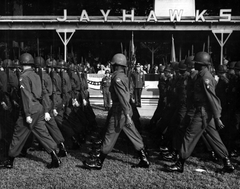
Lieutenant General Louis W. Truman and Troops on Parade During Assumption of Command Ceremony
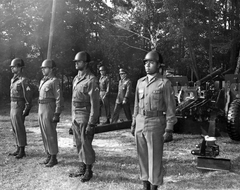
Lieutenant General Louis W. Truman Assumes Command of the United States 7th Army Corps
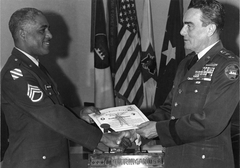
Staff Sergeant Eddie Preston-Chirstain Receives a Certificate of Achievement
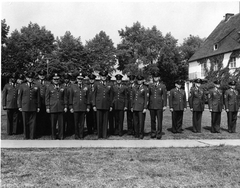
Group Photograph of 35th Artillery Group at Kelley Barracks, Stuttgart, Germany
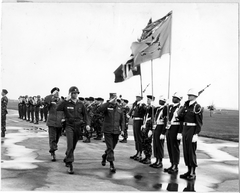
Lieutenant General Louis W. Truman Visits 11th Armored Cavalry Regiment
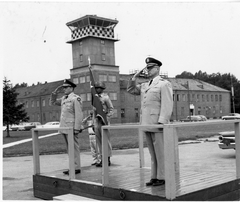
Lieutenant General Truman and Colonel Donald P. Boyer in Ceremony for 11th Armored Cavalry Regiment
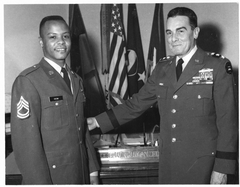
Sergeant First Class Isom is Promoted by Lieutenant General Louis W. Truman
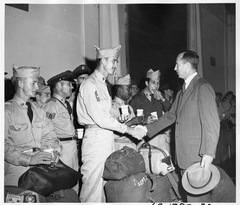
Secretary of the Army Frank Pace Greeting Troops at Fort Mason, California
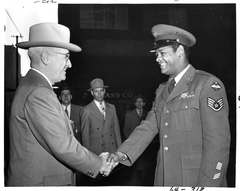
President Harry S. Truman Shakes Hands with African American Air Force Sergeant
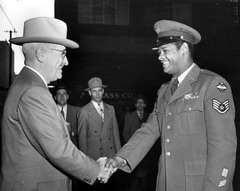
President Harry S. Truman Shakes Hands with African American Air Force Sergeant
